My favorite way to identify birds is to use the Merlin bird ID app. It will help you identify the birds you see, for 6,000+ birds. And, it’s free!
Transforming your backyard into a bird-friendly sanctuary is easier than it seems...The birds need shelter from the elements and protection from predators. You can help by creating areas in your backyard where birds can seek refuge.
7 Reasons to Bird Watch with Your Kids
Birding is an easy way to add more nature to your life.
The whole family (even young children) can participate.
It can be done any time.
It can be done anywhere. Birds live everywhere!
You don’t have to leave your house. You can bird watch from a window.
Supplies are inexpensive.
“Birding awakens the senses.”
By observing birds, their calls, and their habitats, individuals can enhance their sensory awareness and appreciation for the natural world. This practice can foster mindfulness, reduce stress, and improve overall well-being.
Making DIY bird feeders is a hands-on activity that’s both fun and educational. This not only helps attract more birds but also gives kids a sense of accomplishment and a closer connection to nature.
You’ll want a (affliate link) good camera. Unfortunately, the camera in your phone probably won’t get you the best shots of birds. If you need to buy one, take a look at this list of good birding cameras.
Superscript
How to Discover the Joy of Birdwatching with Kids
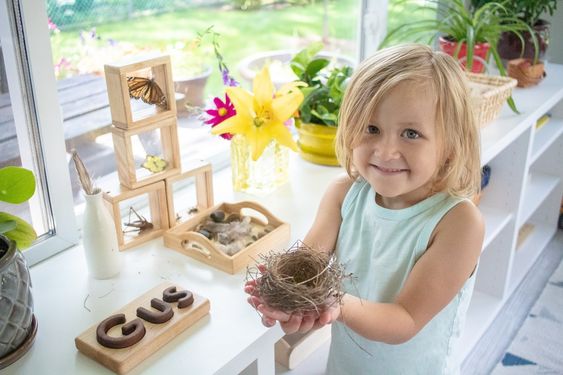
How did I ever miss the discovery that birdwatching is fun??! Even though I had good teachers growing up, I didn’t have teachers who were passionate about science. Birdwatching is definitely multi-sensory outdoor play.
🐦 Make a Bird Feeder
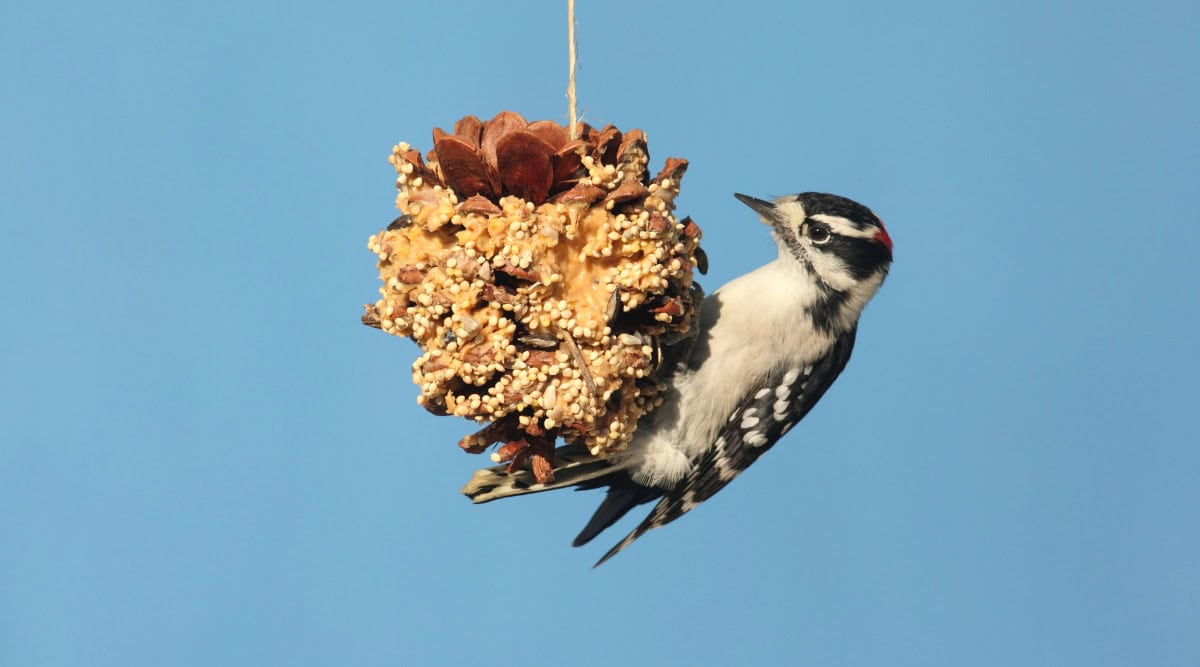
Create a simple and fun bird feeder with your kids to attract and feed local birds. A favorite method is to coat a pinecone with peanut butter and roll it in birdseed. You can also use an extra pumpkin or gourd by removing the top and filling the base with birdseed for a natural feeder.
Benefits: Learn about local wildlife, experience outdoor observation, and promote creativity and hands-on activities.
Supplies: Pinecones, peanut butter, birdseed, an extra pumpkin or gourd, and a knife (for adult use only).
Tip: Hang the bird feeder in a visible spot near a window so your kids can watch the birds that come to visit.
🐦 Backyard Bird Watching
Set up a bird feeder (homemade or bought) in your backyard and observe the different birds that visit during the fall. Start by listening to their calls and using a local guide to identify them. For a better variety, bird watching can be done near water.
Benefits: Teaches about local wildlife and encourages a connection with nature
Supplies: Bird handbook, bird feeder (see below), bird seed.
Tip: Keep a simple bird guidebook handy to identify different species. If live birds are hard to find, look for signs of bird activity, like nests or feathers.
☀️ Shadow Play
On a sunny day, use chalk to trace the shadow of your toddler or other objects on the ground. Talk about how the sun’s position affects the shadows.
Benefits: Encourages curiosity about nature and spatial awareness.
Supplies: Chalk, leaves, and other objects.
Tip: Pair this activity with a story about the sun and shadows.
🏡 Birdhouse Crafting
Build or decorate a birdhouse together. Hang it in your yard and watch for birds that may visit during the fall.
Benefits: Encourages creativity and a connection with nature.
Supplies: Birdhouse kit or materials, paint, brushes.
Tip: Use non-toxic paint and add birdseed inside to attract birds.
We did some bird study as homeschoolers, but the available Montessori-friendly materials for homeschoolers were more limited pre-Internet. Now, I’ve discovered that birdwatching is an amazing activity for both kids and adults! I’ll tell you from my experience how to discover the joy of birdwatching with kids.
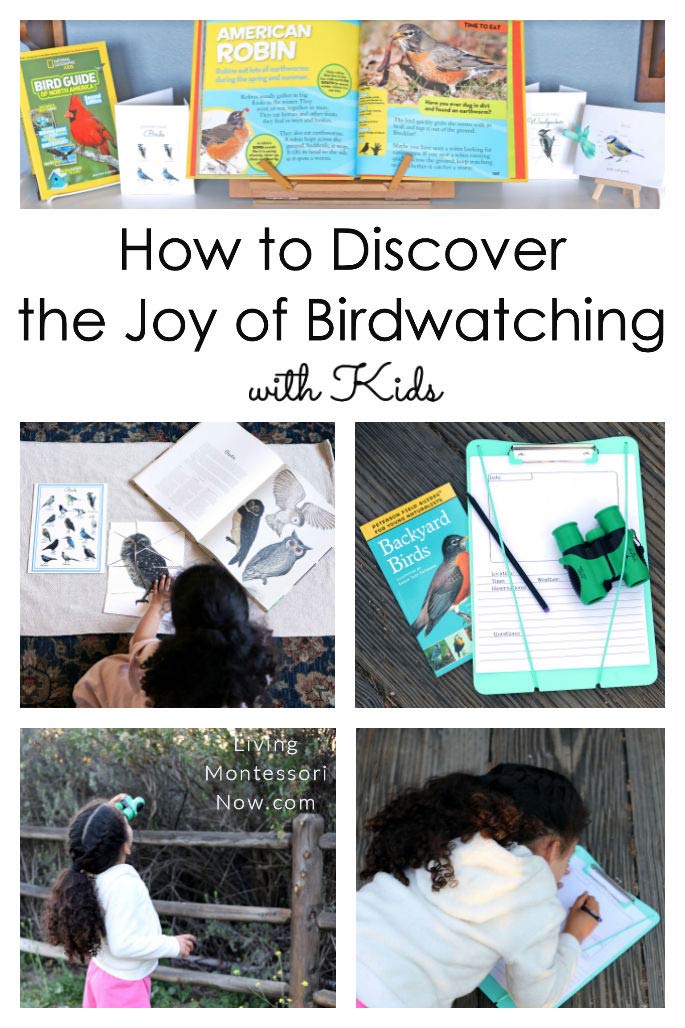
Easy Ways to Get Kids Birding
Kids are natural explorers. Here are some tips and games to encourage that impulse from Audubon experts. By Marina Pita
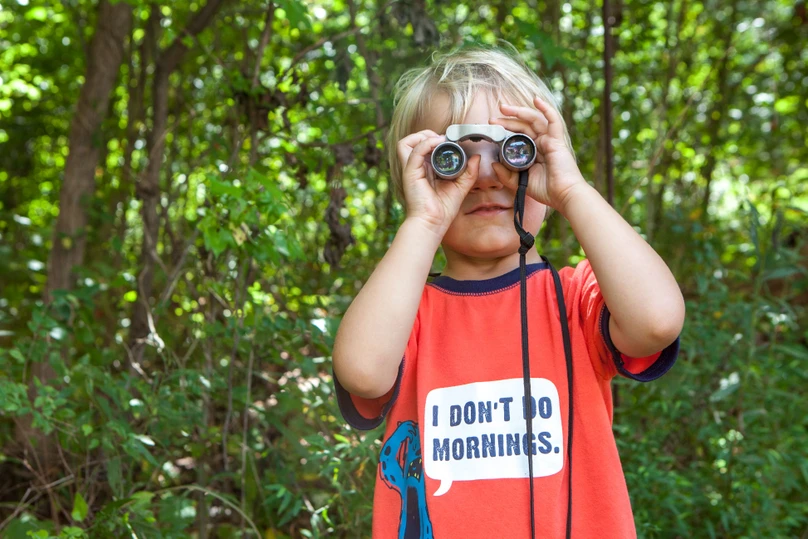
Birding is awe-inspiring. It connects us with a sense of place, and gets us outside to explore our neighborhoods and towns. It's also great for travel: One of my favorite things to do when I visit a new place is to go for a walk in the morning to see what species I encounter.
So how do you make this wonderful pastime more engaging for children? I'm the Community Programs Manager at Seattle’s Seward Park Audubon Center, and I often bird with a young crowd in tow through the ancient woods of Washington's Bailey Peninsula. Here are the strategies I use to keep little birders absorbed for hours (or minutes) on end.
How to Bird
Start off by reminding kids that birds are hard to spot, but easy to hear. Have them close their eyes and listen. Can they point to where the song is coming from? I like to teach common mnemonics like the American Robin’s cheery up, cheerio, which can be picked up on almost any bird walk in the United States. Learn some mnemonics for common birdsong here.
Where to Go
You don't need to go far. Birds can be seen on the city street as well as in parks, yards, and nature preserves. It does help if you can stick to areas near water if you can. You’re likely to spy herons, egrets, and swans, which are easier for kids to see. Plus . . . ducklings!
What to Look For
Striking out on live birds? Point out the signs they leave behind such as nests, cracked seeds, whitewash (poop), or owl pellets.
Which Optics to Use
Binoculars can be very hard for young children to learn how to use. Kids also have trouble looking through spotting scopes. Instead, focus on staying still and looking for the movements of birds and other animals. Or, for more fun, make a pair of DIY cardboard binoculars to get your kid into practice.
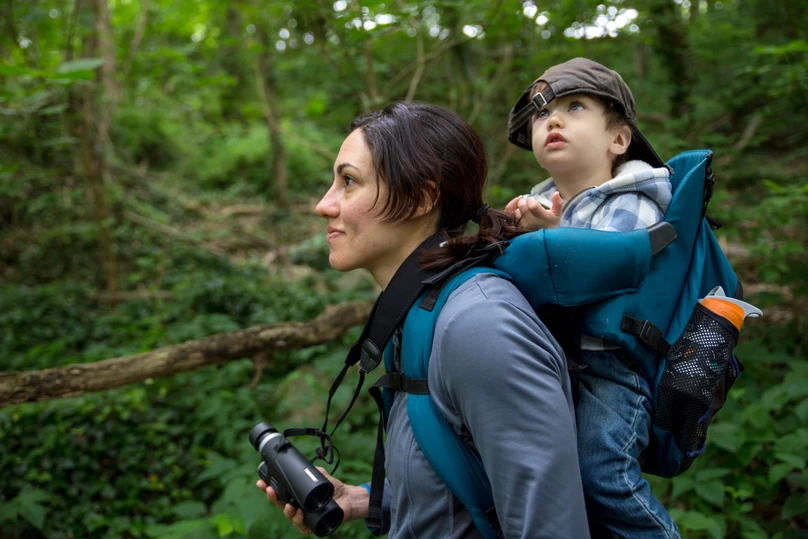
Photo: Camilla Cerea/Audubon
Games
The best way to get a kid interested in birding? Make it a game! Here are three ways Nicholas Lund (The Birdist) puts the "fun" in "birding fundamentals.
Scavenger Hunt
Birding is a game that has a goal: To see as many birds as possible. For some kids, counting up from zero to some arbitrary number—5 different kinds of birds, for example, or 20 birds in one outing—will be enough to stay focused and have fun.
To fire up kids’ powers of observation, make a list of target birds before heading to the yard or park. Use general categories like ducks and hawks or even critters in groups of threes or fours. You could also make a rainbow by finding feathered subjects that cover ROYGBIV.
Follow Your Kids Interests
Birding is a great time to follow what interests your child. Connect with them on all that you catch them wondering about. Outdoor exploration is also a great opportunity to encourage their independence. Let them choose which park, or pull up a map of your area and let them choose which green patch you visit. Once there, let your child choose the trail and lead the way, pointing to objects or areas they want to study as you go.
Binocular Spy
If your child is advanced enough to use binoculars, teach proper usage by asking kids to read signs at varying distances. Start with the closest and move farther away until they’re okay holding the barrels steady and turning the focus wheel. Once those basics are down, play I Spy to have them re-find smaller objects.
Sound Off
Most children know what a pig and dog sound like—but what about a Red-eyed Vireo? Ask kids to imitate the bird sounds they hear, then use a field-guide app to pull up the IDs and play back clips. The key is to let them voice their own translation of the songs and calls
***
Freebie Alert! Don't have a field guide app? Download this handy Audubon Bird Guide App to start learning 821 North American species.
How to Discover the Joys of Birdwatching with Kids
Start with inviting bird books and hands-on activities.
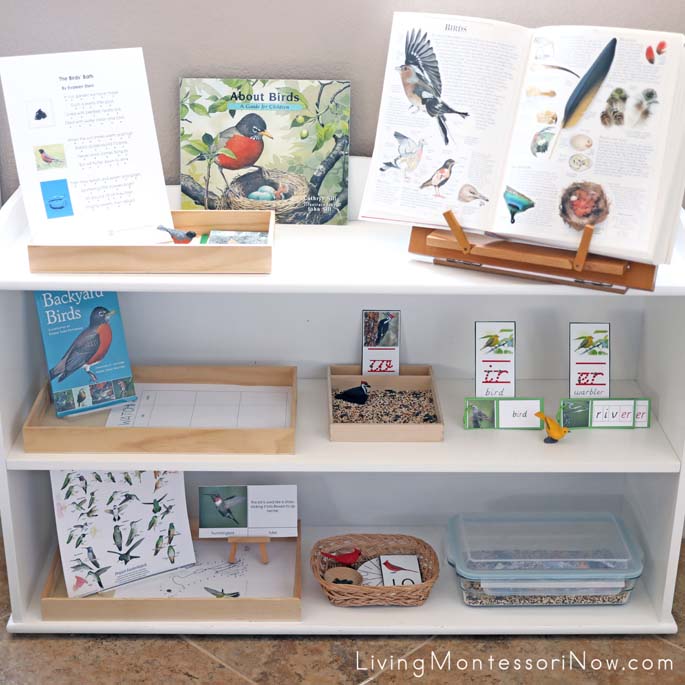
Montessori Shelves with Backyard Bird Themed Activities
We started our bird unit with a number of hands-on bird activities as well as bird books with beautiful photographs or illustrations.
You can see the free backyard bird printables (including my subscriber freebie backyard bird pack) in my post with free backyard bird printables and Montessori-inspired backyard bird activities.
I had many bird books available. You can see my recommendations in my best bird books for kids post.
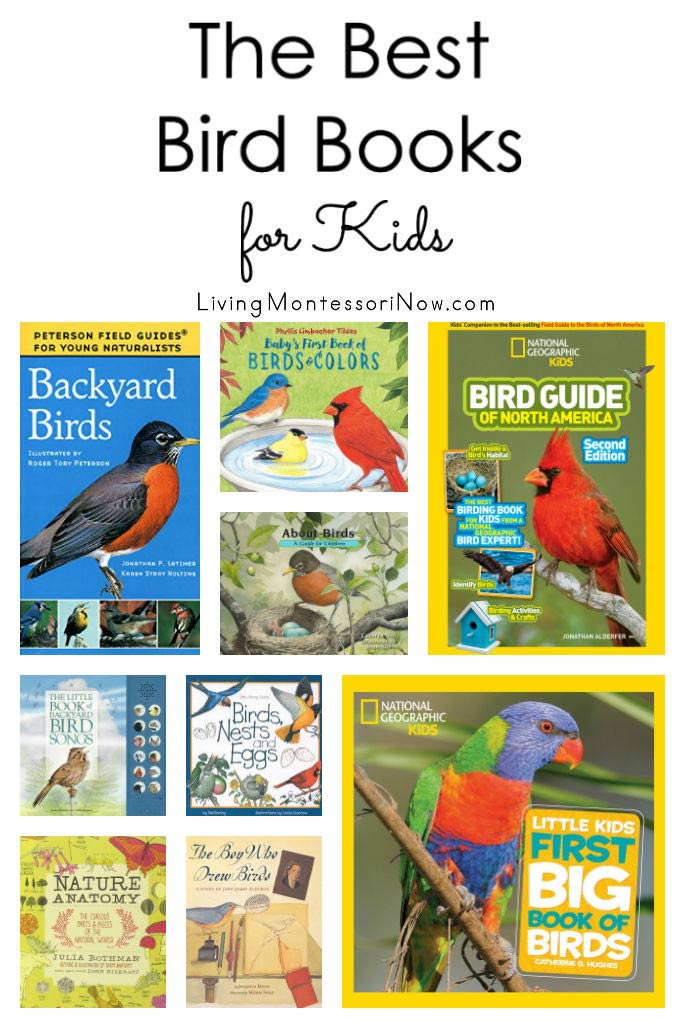
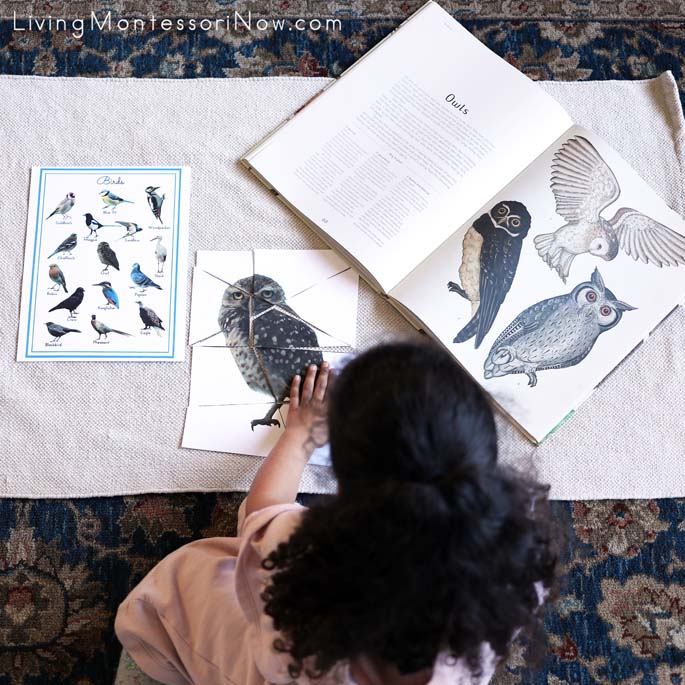
Working with Owl Puzzle and Animalium Book
We have a neighborhood owl, so the first activity we used from the bundle was the owl puzzle along with the poster of 15 birds and the Animalium book (one of Zoey’s favorites). The puzzles are surprisingly challenging and are perfect for a variety of ages.

Montessori Shelf with Bird Books and Montessori Bird Printables
Since then, I’ve had the birds memory game, woodpecker puzzle, and external parts of a bird booklet on my cultural shelf. I love that all the materials in the birds bundle are beautiful. But my favorite parts might be the card holders! The folders for the birds memory game and woodpecker puzzle are examples of the folders that come with each set of cards in the bundle. They have dotted lines for folding so that you can make attractive folders for your cards in two minutes or less! I have limited shelf space, and the card holders don’t take up an excessive amount of space. For home use, I’m always looking for ways to save time and space. (Note: To see my shelf in a larger size, open the image in a new tab.)
I don’t typically laminate my materials for home use (except for toddler printables and printables that will be used in or near water). I adore materials like these that are very attractive, professionally done, and can be prepared very quickly! I still have so many activities left in the bundle that I can easily prepare. Note: The books on my shelf are the National Geographic Kids Bird Guide of North America a and National Geographic Little Kids First Big Book of Birds (which I love to open to a variety of pages, featuring different birds).
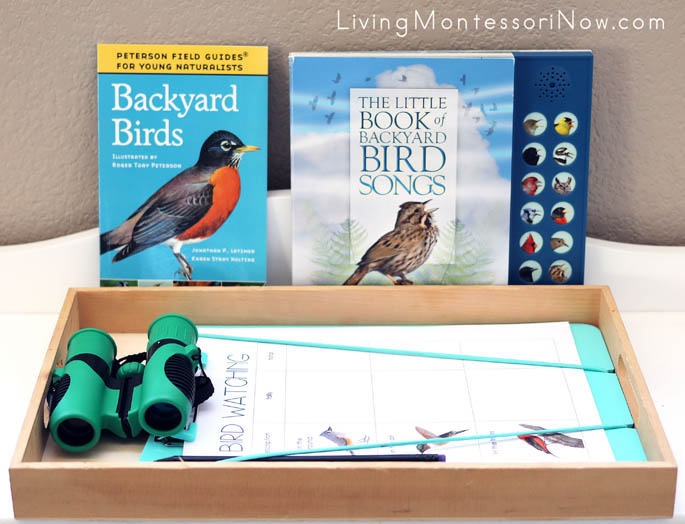
Backyard Bird Books and Birdwatching Tray
On my other bird-themed shelves, I have our backyard bird books and birdwatching tray. On the tray are the free printable Bird Watching Record by Tanglewood Hollow at Teachers Pay Teachers, some pages from the printable nature journal from Twig and Moth, and a clipboard. I also have child-size binoculars that work well and aren’t a toy.
The books are Backyard Birds (Peterson’s Field Guides for Young Naturalists and The Little Book of Backyard Bird Songs. I don’t normally use toys or materials with batteries, but this is a wonderful exception. My 3 grandchildren are all in love with the book, and so am I! It’s so easy to learn the bird sounds and a variety of facts about each bird.
Note: In addition to the video of bird sounds in the bird bundle and The Little Book of Backyard Bird Songs, you can learn to identify bird sounds through this post: Free Bird Sounds, Songs, and Rhymes for Circle Time.
Read the comment in my Instagram post telling how they use The Little Book of Backyard Bird Songs outdoors in forest school to get responses from the birds! I can’t wait to try that!
Use your new knowledge to go on birdwatching nature walks!
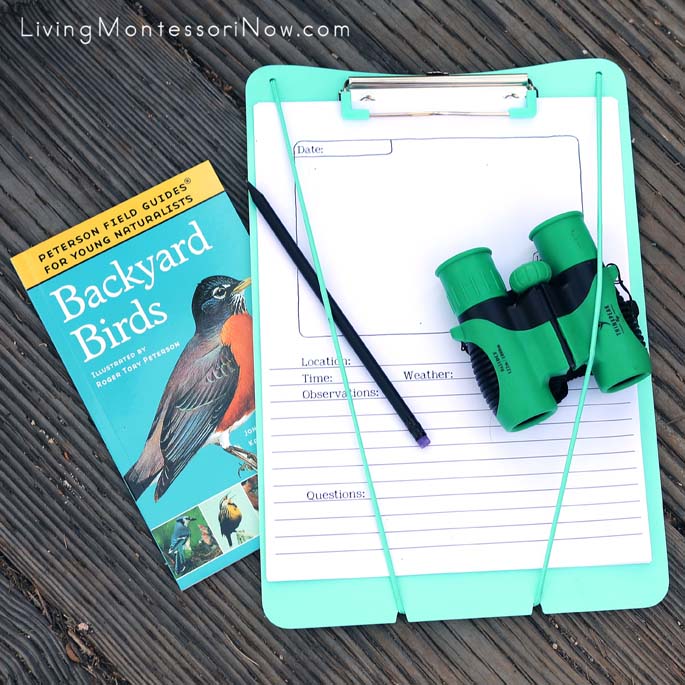
Birdwatching Materials – Backyard Birds Book, Nature Journaling Pages, Pencil, Binoculars, and Clipboard
Zoey, Sophia, and I have gone on two birdwatching nature walks at a nature area and park. We’ve had so much fun with this! I heard a mourning dove in the parking lot and was so excited to easily identify it! Zoey could easily identify the sounds of the crows as we walked to the nature area.

Using Binoculars on a Birdwatching Nature Walk
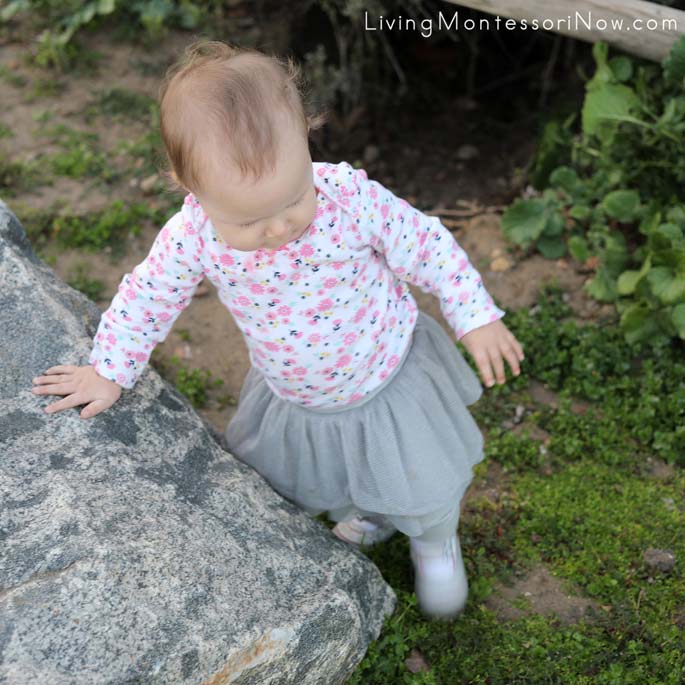
Nature Walk Fun at 15 Months
Sophia isn’t interested in using the binoculars yet, but she loves the nature walks, too.
We’re having so much fun with birds and bird songs that I plan to keep our bird tray in an accessible place throughout the year. Not only can we observe birds from our back window and balcony, but we can easily pick up the materials to go on another birdwatching nature walk! Listening to and identifying bird songs is quite meditative, too … a perfect mindfulness activity (and a wonderful auditory sensorial activity) for us all!
More Bird Activities and Resources
Free Backyard Bird Printables and Montessori-Inspired Backyard Bird Activities
Montessori-Inspired Owl Unit with Free Printables and Activities
Great Horned Owl Do-a-Dot Printable (Montessori-Inspired Instant Download
Montessori Nature Tray with Owl-Themed Craft and Art Appreciation
Free Owl Cutting Strips (Montessori-Inspired Instant Download
Free Nest Printables and Montessori-Inspired Nest Activities
Free Nest Do-a-Dot Printable (Montessori-Inspired Instant Download)
Montessori Nature Tray with Bird-Themed Nest Building and Art Appreciation
Free Duckling Printables and Montessori-Inspired Duckling Activities
Free Make Way for Ducklings Do-a-Dot Printable (Montessori-Inspired Instant Download)
Free Birds Do-a-Dot Phonics Printable (Montessori-Inspired Instant Download)
Bird Watching for Kids
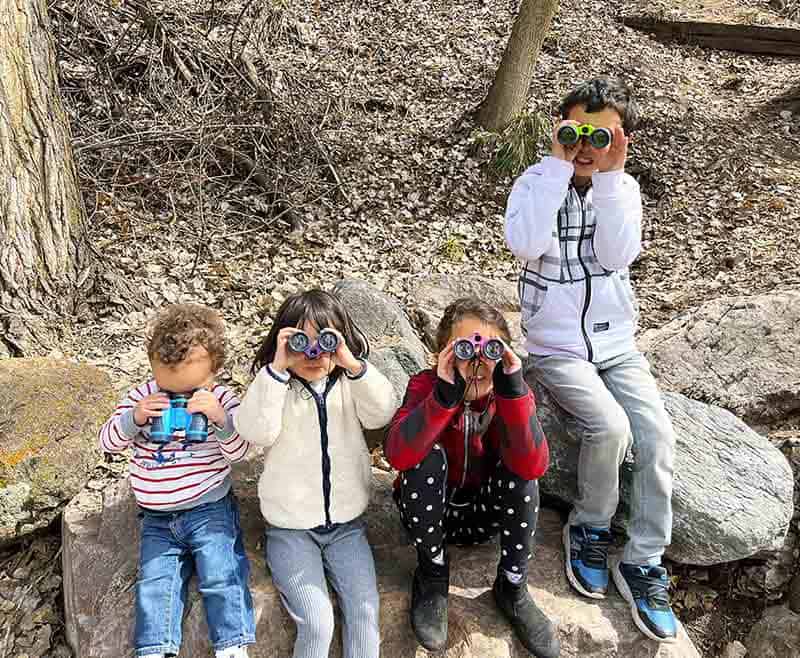
Do you love birds? Have you ever been on a nature walk with your kids or grandkids observing and watching birds?
There is something special about birds—their striking colors, amazing flying abilities, and melodious singing voices—that make them incredibly unique.
Author and naturalist, Julie Zickefosse said, “The presence of a single bird can change everything for one who appreciates them.” (“Saving Jemima: Life and Love With a Hard-Luck Jay.”)
I agree. I appreciate birds and to encourage my grandkids’ interest in and appreciation for birds, we’ve taken them “birding,” and engaged in bird watching activities and games. It’s paying off…
Before I share our bird watching activities for kids and grandkids, here is a yearly bird activity to mark on your calendar; a wonderful website for more ideas and activities on bird watching for kids and a book filled with fabulous bird information
The Great Backyard Bird Count
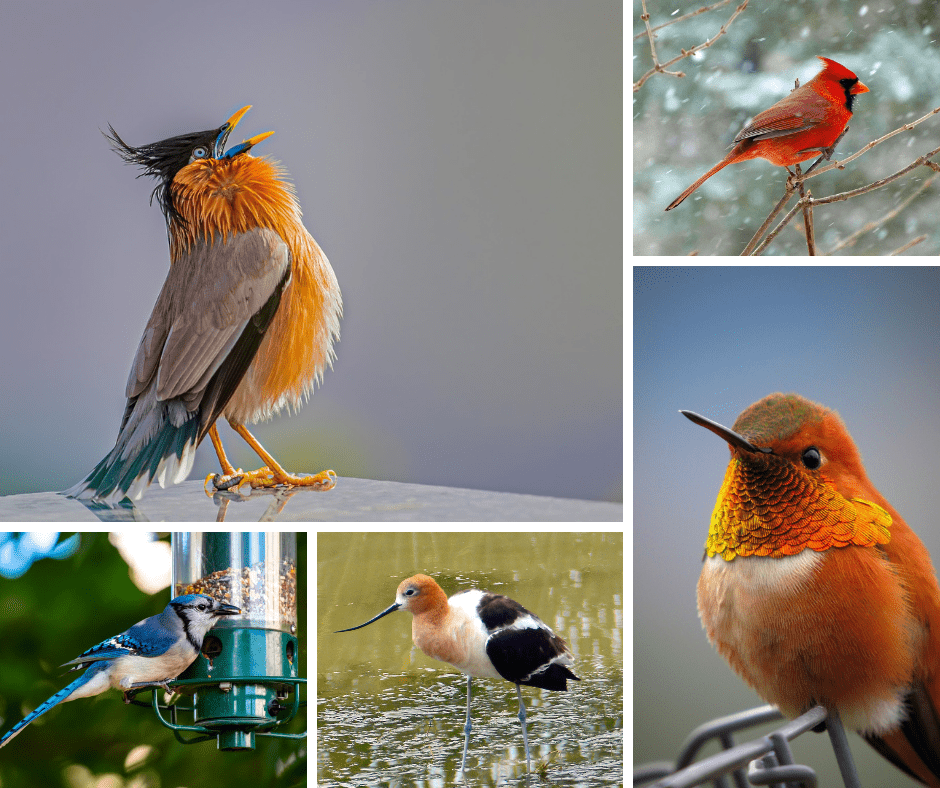
This event happens every February all over the world and can be done in your own backyard! Spend about 15 minutes with your kids/grandkids in your backyard each day watching for birds. Mark down how many birds you see; any details about the bird’s behavior; the type of bird, or even draw a picture. Submit your findings online to the Great Backyard Bird Count.
Audubon Society for Kids
A great site that is filled with information about birds. Click here to learn more
Nature Anatomy by Julia Rothman
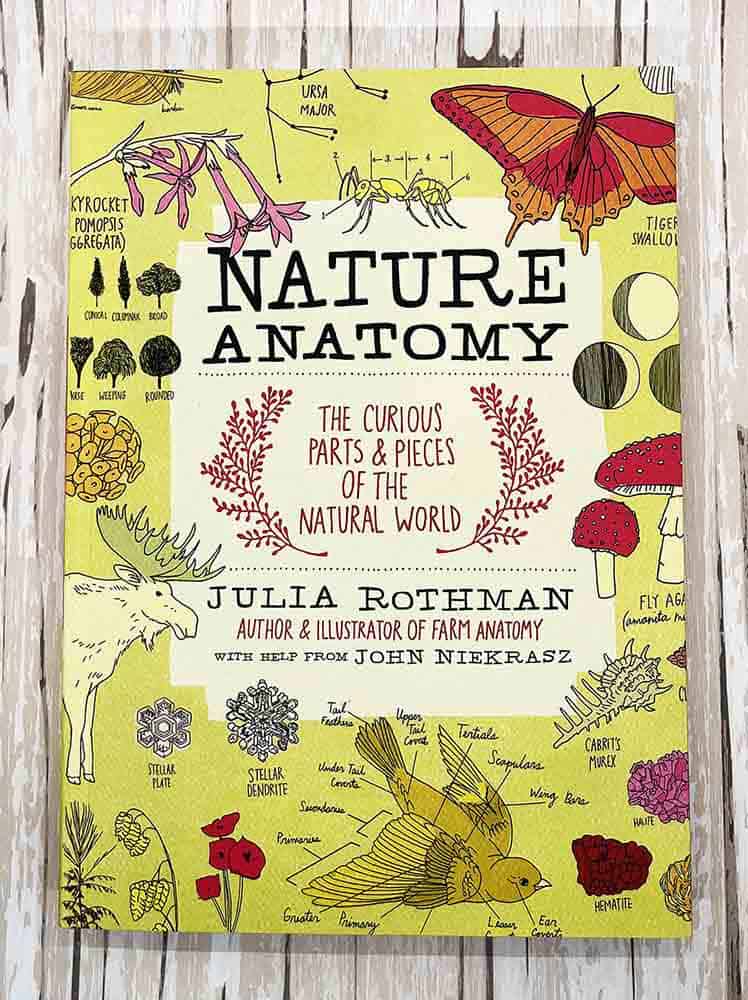
If you and your kids/grandkids are nature lovers—I highly recommend this book. There is an in-depth chapter on birds and includes detailed pictures and topics on birds such as:
Anatomy of a Bird
A Bevy of Birds—pictures and information on 24 birds
Kinds of Bird Feathers
Birdcalls
A Variety of Bird Nests
Different Kinds of Bird Eggs
Bird Behavior
Birds of Prey
A Variety of Beaks
Now, get ready for some amazing activities, games, books, and DVDs all about birds and bird watching for kids and grandkids!
Bird Family Passions
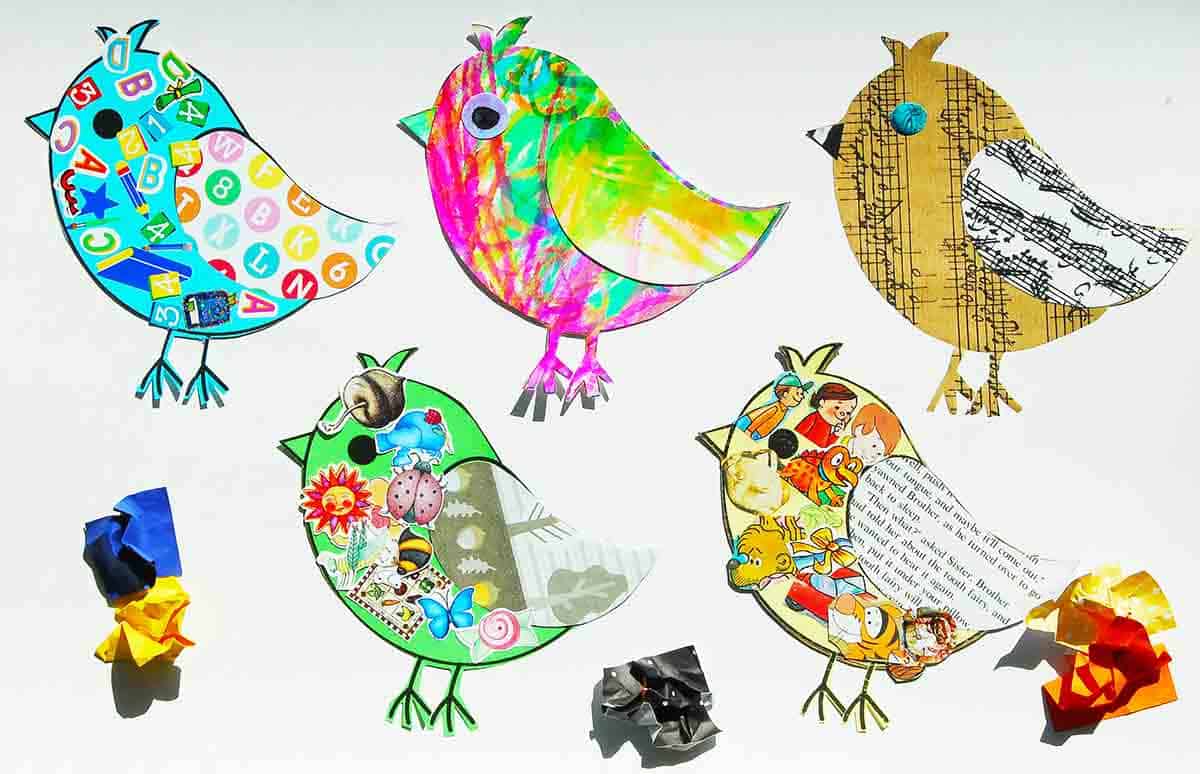
Every family is passionate about something. In our family and extended family, we are passionate about:
Art
Literature
Music
Lifelong learning
Nature
And too many more things to list…
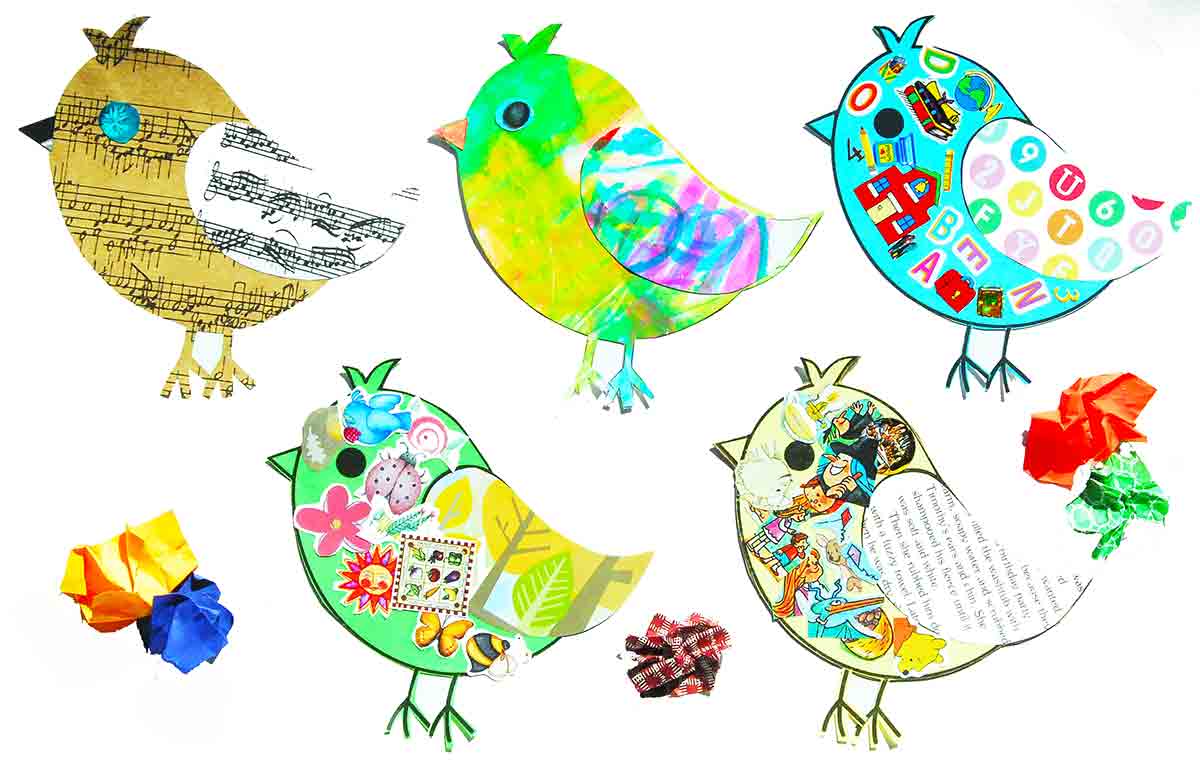
We combined our passions with our love of birds and made a bird family of 5—each representing one of our passions.
What are your family’s passions? Write down 5 things you are passionate about and want to pass down to future generations and use birds to illustrate each passion.
We gathered pictures and text from children’s books; music paper, symbols of nature and learning, and some of our grandkids’ art drawings.
We snipped and cut everything and then designated one bird for each passion and glued on the symbols related to that passion.
The end result—our colorful “Bird Family Passions!”
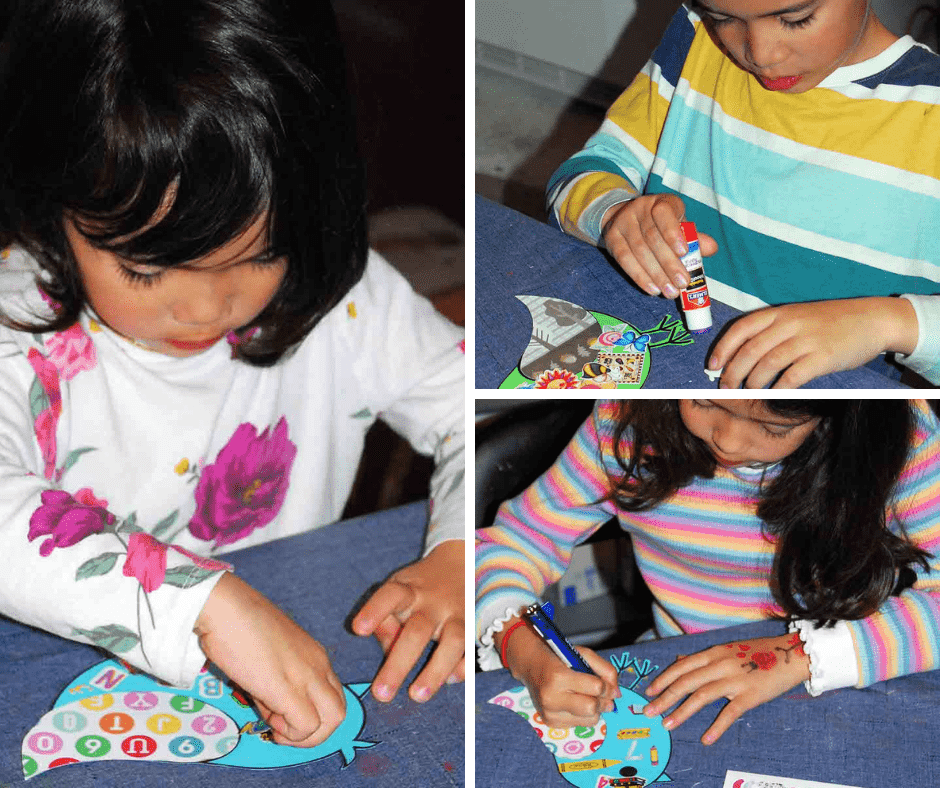
Supplies
Illustrations that represent the passions that your family has. Ours included pictures from books, music paper, nature (flowers, trees, birds, etc.), and even stickers symbolizing learning
Posterboard
Cardstock in 5 different colors
Directions
Download the free bird template and print off 5 birds in different colors of cardstock—5 birds for each child
Take the symbols representing your family’s passions and designate one bird per passion and fill it with the symbols that represent that passion
The bird that represented “art,” the kids took some of their artwork; traced the bird on the artwork, and cut it out. They were very colorful and a great way to recycle (see below)
Mount your 5 birds on a poster board
Recycled Art Birds
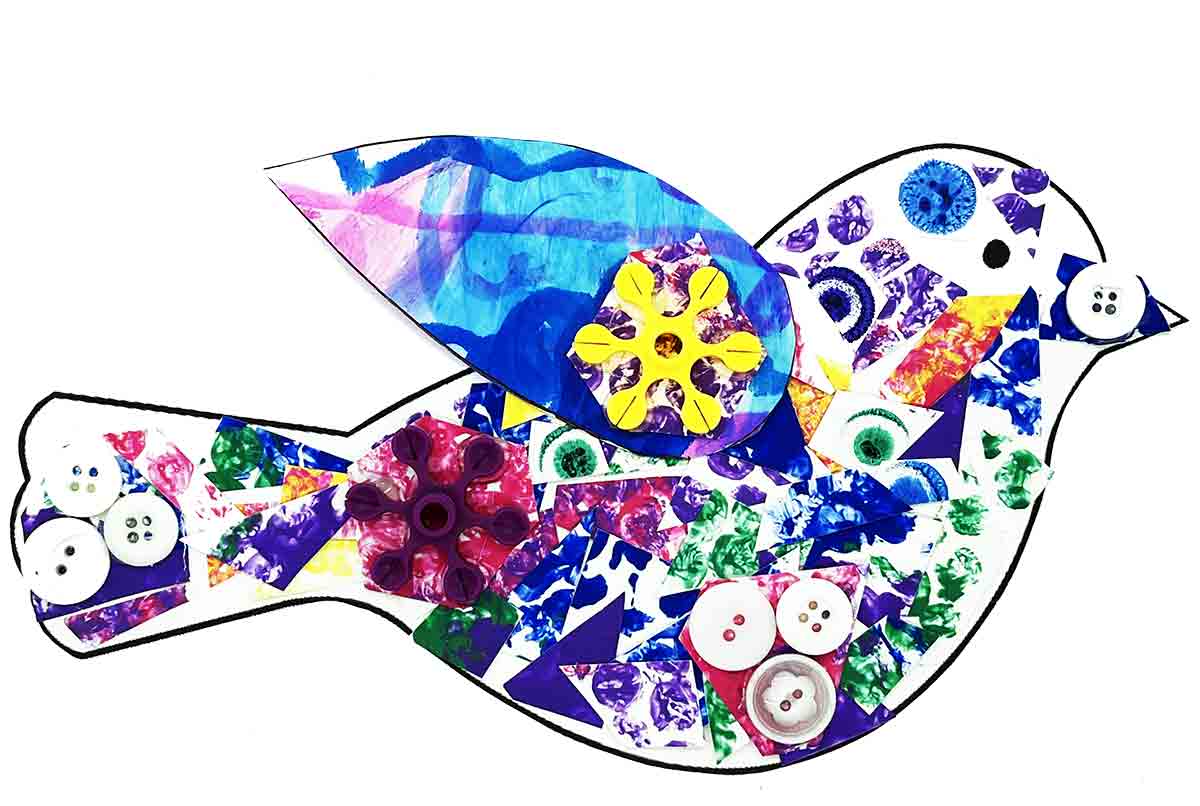
Have you ever wondered what to do with all your kids/grandkids’ art projects that have been hanging on the wall for years? Don’t throw them away! Recycle them into another project.
For these recycled art birds—the grandkids took their art projects and cut them up into various shapes and sizes. Included were their bubble wrap paintings; spin-art paintings; shaving cream paintings, newsprint drawings, and random scribbles.
From these bits and pieces, they created very colorful birds while giving another life to the artwork that was ready for the trash!

Supplies
White cardstock
Old artwork from your children/grandchildren
Scissors
Glue stick
Directions
Print the bird template on cardstock paper—one per child
Take old artwork and cut it into different shapes and sizes
Arrange the cut up pieces of artwork on the bird
Glue in place
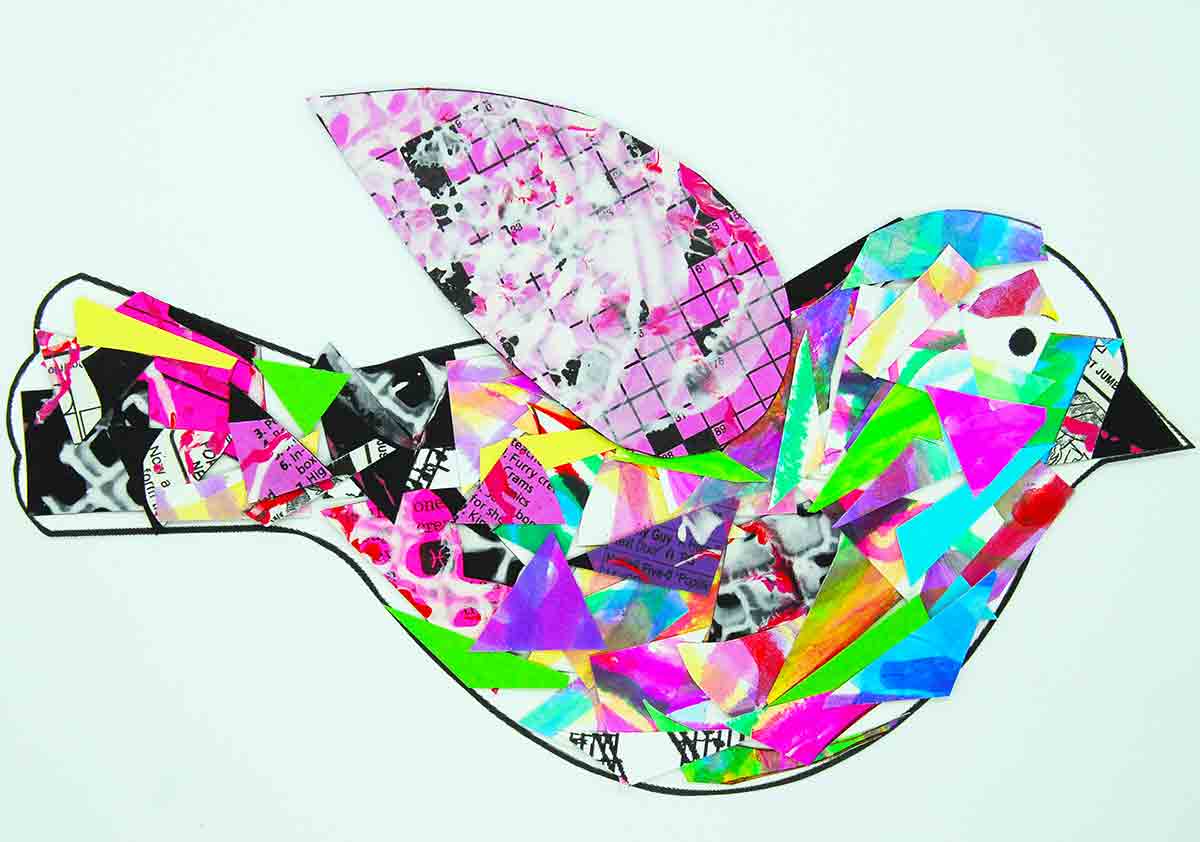
Bird Watching for Kids:
An Educational & Fun Activity
The best way to teach your kids/grandkids about birds is to take them out birdwatching because kids learn best by doing…
There are a few supplies you’ll need. Click here for my comprehensive bird-watching supply list.
Most importantly, you need binoculars purchased in a variety of colors. Each child/grandchild should have their own binoculars.
Choose different places to go to look for birds—your backyard, neighborhood parks, hikes in the mountains, or by the ocean—the places are endless because birds are everywhere!
Every season of the year is good but the best times to see birds are dawn and dusk.
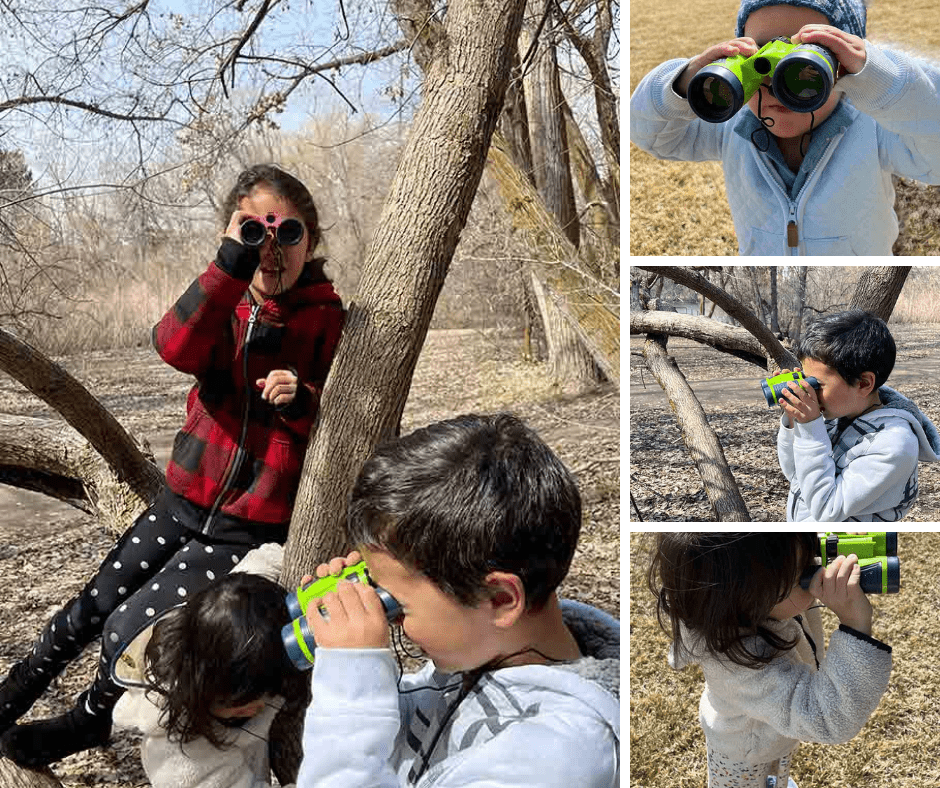
Here are some things to watch for when bird watching:
Look for feathers on the ground (birds are molting and feathers indicate species)
Birds singing or bird calls (sometimes you hear birds before you see them)
Look for bird nests—some are high in the trees, others on the ground
Check out anthills—you may see birds lying near because ants leave traces of formic acid on their wings which repeals parasites
Look by water—the birds may be bathing
Grab your kids/grandkids and get going for the experience of a lifetime!
Bird Feeders from Pinecones, Peanut Butter & Birdseed
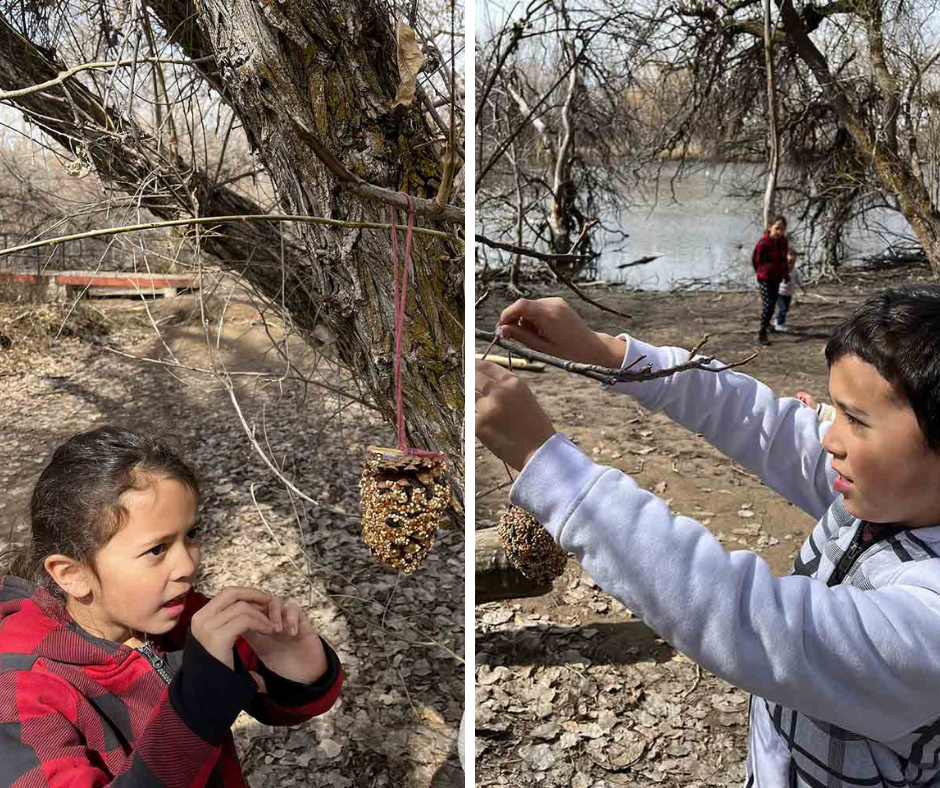
Have you made a bird feeder before? They’re easy and require very few supplies—pinecones, peanut butter, and birdseed.
When finished you can hang them in your backyard, or at a nature park. Since we’ve made bird feeders and birdhouses and hung them in our backyard to attract birds, we decided to hang these bird feeders in the trees at a nature park. Either place is ideal and will provide wonderful food for the birds.
It’s a fun sensory project as your kids/grandkids get their hands in gooey peanut butter and little bits of birdseed!
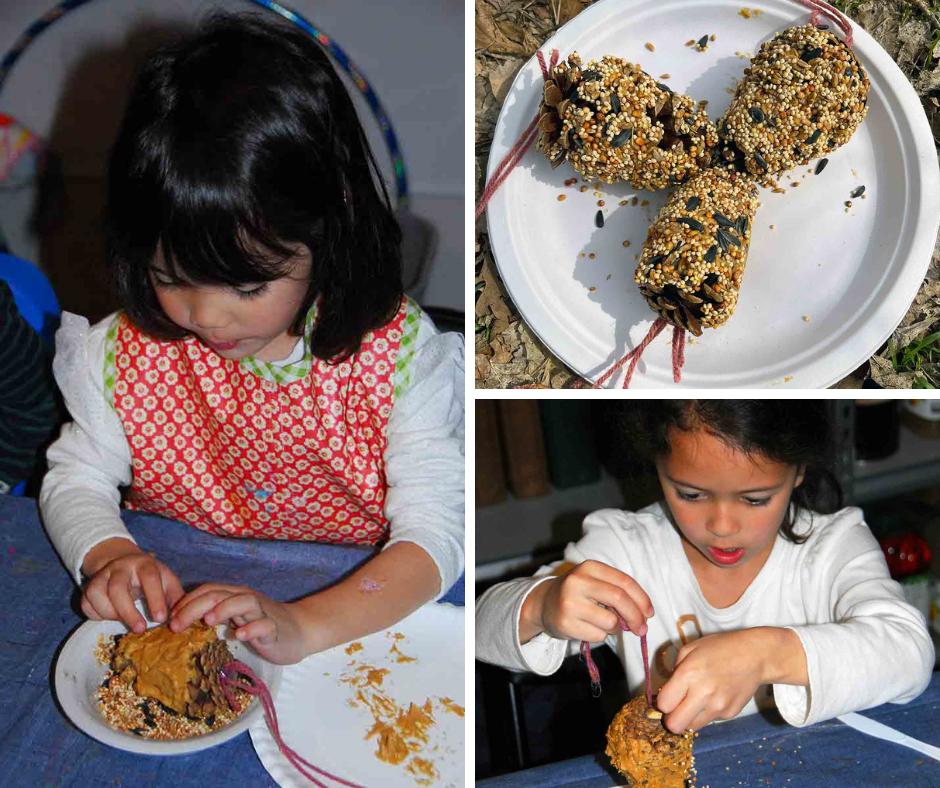
Supplies
Smooth peanut butter
Large pinecones
Yarn
Hot glue gun
Plastic knives
Directions
Give your kids/grandkids bowls of smooth peanut butter and a plastic knife and have them carefully spread the peanut butter over the pinecone
Roll the pinecone in birdseed
Hot glue a long piece of yarn at the top of the pinecone. You want to be able to attach it to a tree limb.
Either in your own backyard or nature park, hang your birdfeeders on a tree.
Bird Filler Games & Activities
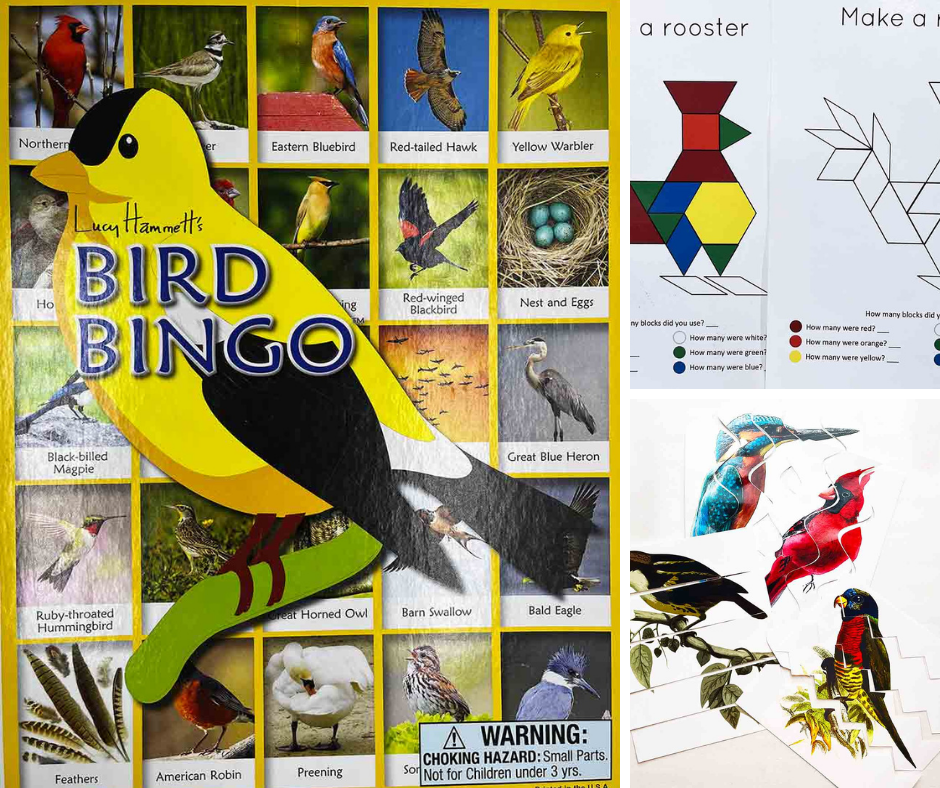
Here are 3 bird activities that I used as bird “filler” activities—something to keep the grandkids busy while I prepare for the next project. They include a game, puzzles, and pattern-block birds. All three of these activities build spatial intelligence—important for reading, math, and language!
Bird Bingo
I purchased this game from Amazon and we’ve played it with the grandkids dozens of times—they love it! What I really like about this Bird Bingo is that all the cards show pictures of real birds—not drawn, which helps if you want your kids/grandkids to be able to eventually identify birds.
Purchase some simple prizes for the winners to add to the fun!
Supplies
Homemade Bird Puzzles
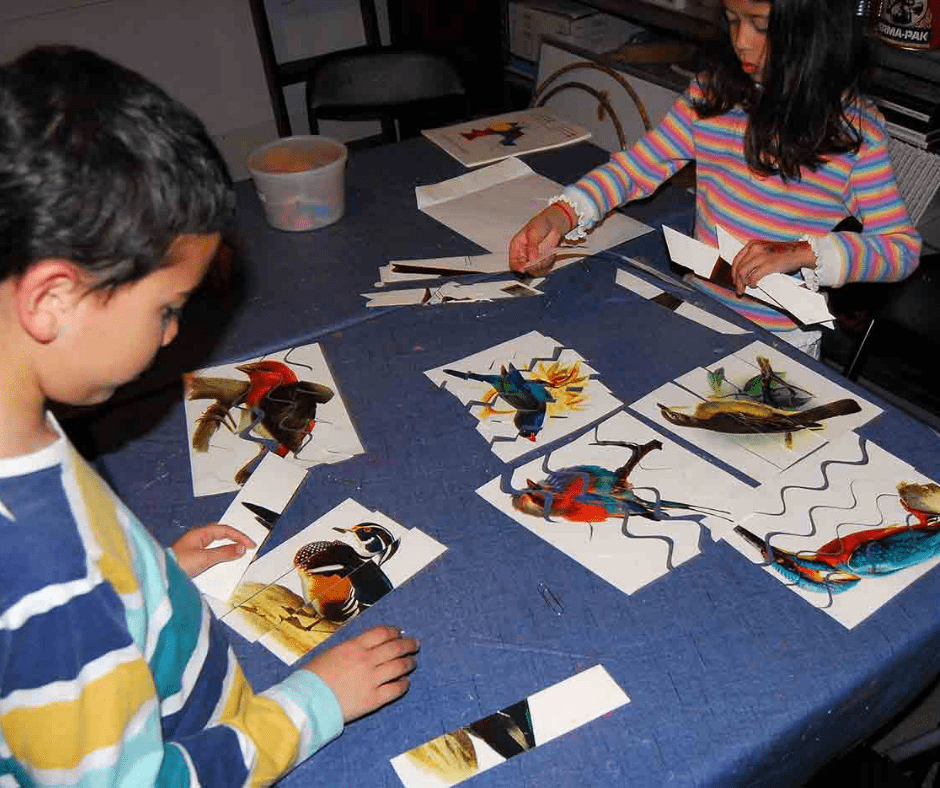
I downloaded these beautiful bird pictures from Danielle Hansen of Harbor & Sprout. I’ve purchased some of her bundles, too. These drawings are gorgeous! I printed them out on cardstock paper; laminated them and then made them into puzzles.
Make swirl, zig-zag, vertical, horizontal, and diagonal cuts—to make each puzzle interesting and different.
I’ve made lots of puzzles for the grandkids using purchased clipart. They are a great activity when you’re looking for something quick, fun, and educational.
Pattern Block Birds
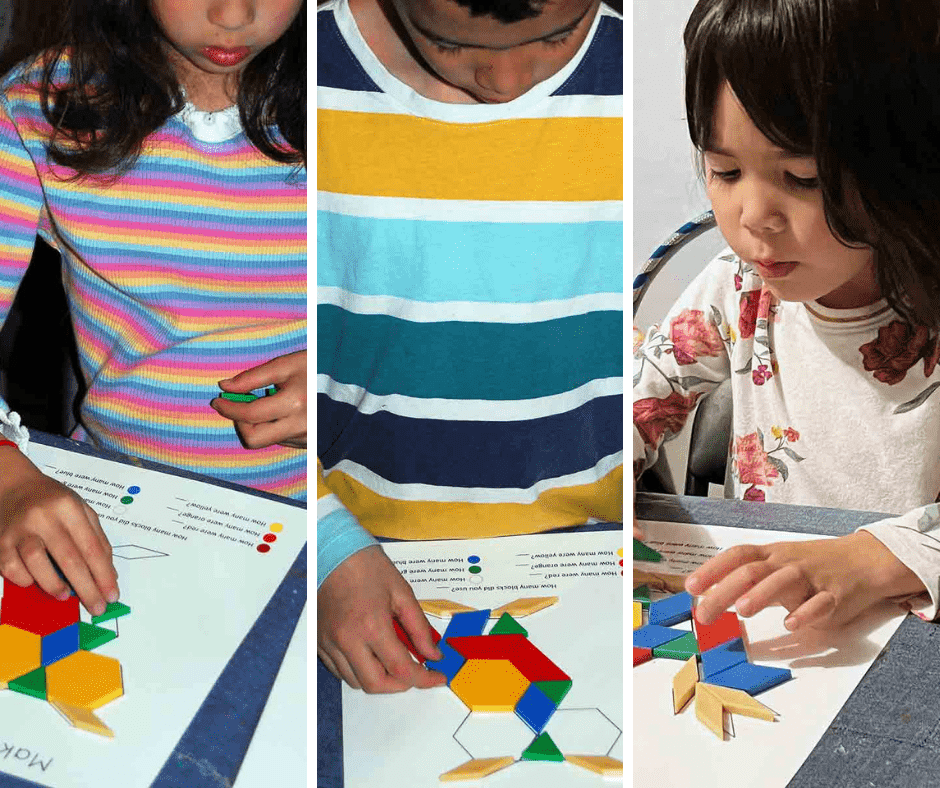
Many years ago, when our sons were young, I purchased a large set of pattern blocks and pattern block pictures for the boys to use.
This activity used pattern blocks and pictures of birds that I found on Adventures in a Box. They are fabulous and FREE! Simply download, print on cardstock paper; laminate; add pattern blocks and your kids/grandkids are free to create!
Like puzzles, this is a great spatial activity for kids—which builds important math skills!
Books, Magazines & DVDs about Bird Watching for Kids
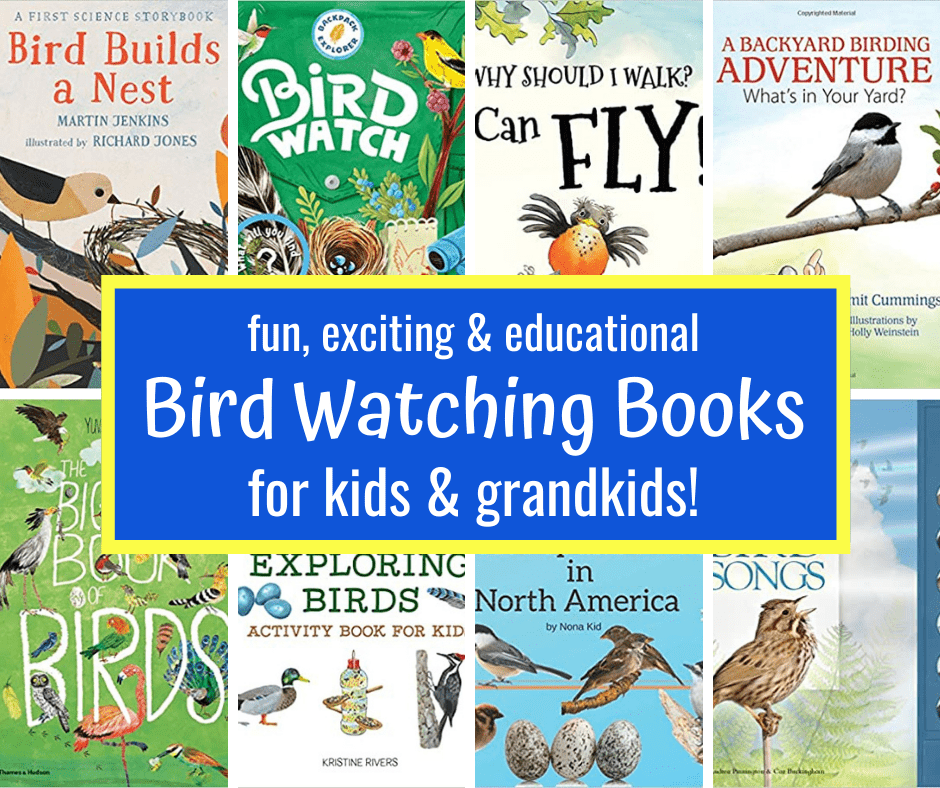
Here are some fabulous books, magazines, and DVDs about bird watching for kids & grandkids.
“Birds & Blooms” is a subscription magazine. Getting a monthly magazine is a great way to spark continual enthusiasm for birds with your kids/grandkids!
Are you familiar with The Great Courses? I’ve been purchasing DVDs and streaming downloads from this company for 20 years. A DVD I have about birds is “National Geographic Guide to Birding in North America.” They offer DVDs and video downloads on every subject imaginable—a great way to become a lifelong learner! NOTE: subscribe to their mailing list–they will send you fantastic offers. Don’t pay retail!
Last, check out these bird-watching books for kids and grandkids.
A Backyard Birding Adventure: What’s in Your Yard by Kermit Cummings
The Big Book of Birds by Yuval Zommer
The Most Popular Birds in North America: Bird Watching Guide for Kids by Nona Kid
Why Should I Walk? I Can Fly! By Ann Ingalls
Bird Builds a Nest: A First Science Storybook by Martin Jenkins
Backpack Explorer: Bird Watch: What Will You Find by Editors of Storey Publishing
Exploring Birds Activity Book for Kids by Kristine Rivers
The Little Book of Backyard Bird Songs by Andrea Pinnington
Get To Know Your Backyard Birds:
Explore Your Backyard Series
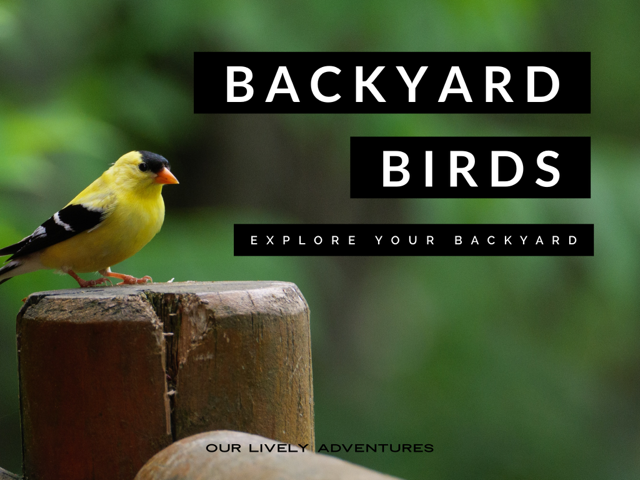
Hi, friends! You know those memes that joke about how quickly bird-watching becomes a hobby when you get older? Well, I’m here to tell you that it’s a joke because it happens! There is a point in every adult’s life when birds become fascinating creatures!
A few months ago I put up a couple of bird feeders outside our kitchen window. I had no idea how much joy I was about to get from those dang bird feeders! I can sit all morning and watch those little cuties. It’s wild.
For a summer project, I thought it would be fun for the kids and me to learn about the different birds that frequented our feeder. That’s the kind of stuff you remember forever, ya know?
Every time I see a forsythia bush I think of my mom because she would drill it into our heads every spring as kids.
I’ve put together this post about 12 of the most common backyard birds in my area, which is southern Indiana/Midwest-ish. I’ve included a picture of each bird along with a few fun facts.
Northern Cardinal
Eastern Bluebird
House Sparrow
Goldfinch
Red-Winged Blackbird
Mourning Doves
Carolina Chickadee
Tufted Titmouse
Blue Jay
Robin
White-Throated Sparrow
House Finch
A way I’ve decided to make this a little more fun for us at my house is to tape a picture of each bird on the window where our bird feeders are located. I can create a backyard bird printable if anyone is interested. Let me know in the comments below if you do and I’ll share mine.
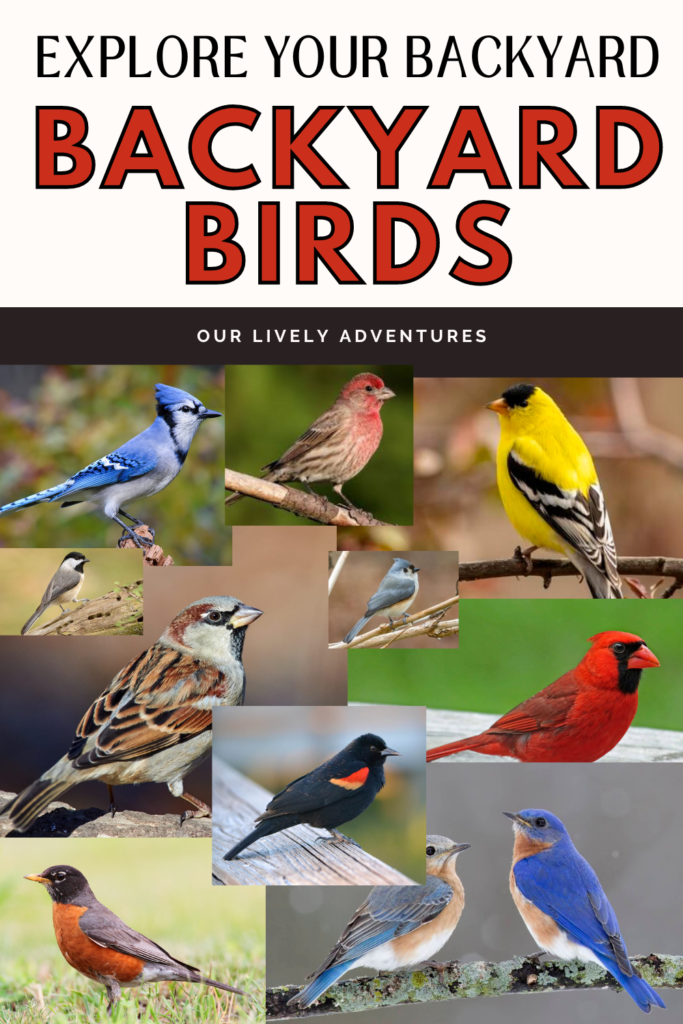
Explore Your Backyard
Check out more in the Explore Your Backyard series!
Your Backyard Birds
Northern Cardinal
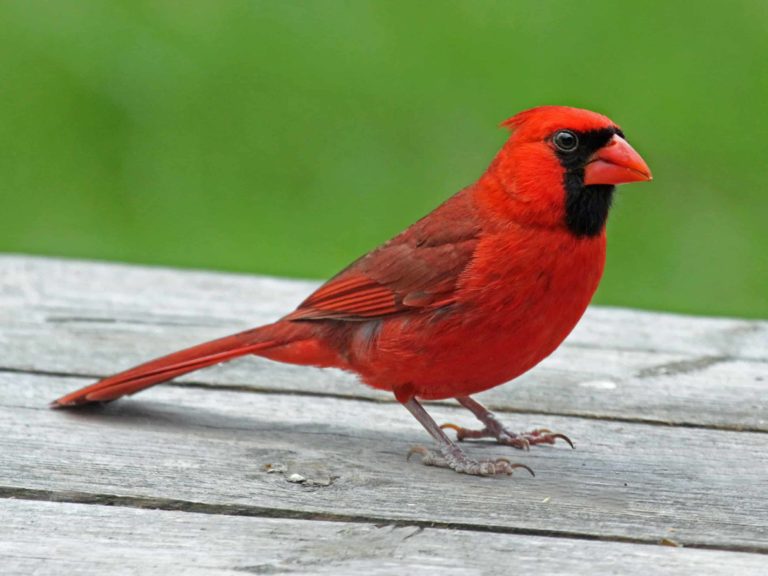
Males are bright red. Females are light brown.
Red feathers are due to diet.
Mate for life.
Average lifespan is 3 years.
Official state bird of 7 states: Illinois, Indiana, Kentucky, North Carolina, Ohio, Virginia, and West Virginia.
Eastern Bluebird
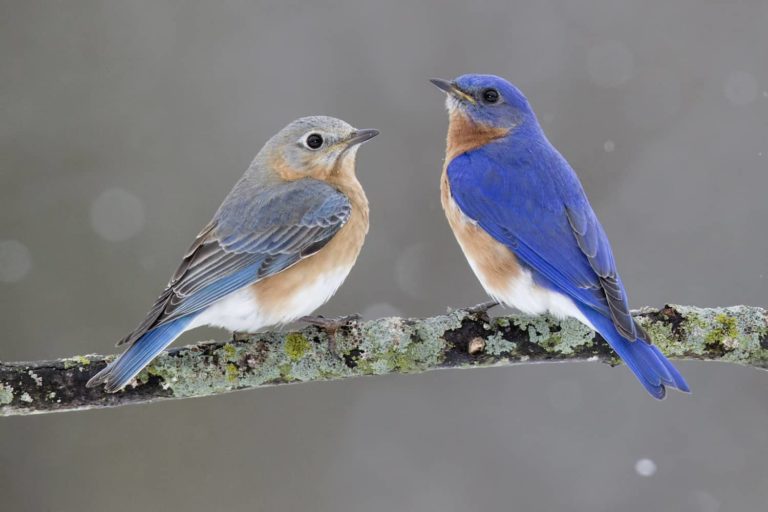
Males are dep blue above and rudy red on the throat and chest.
Females are gray above with blue wings and an orange chest.
Average lifespan is 6-10 years
Prefer to find old nests made by other species and reuse them rather than building a new nest.
House Sparrow
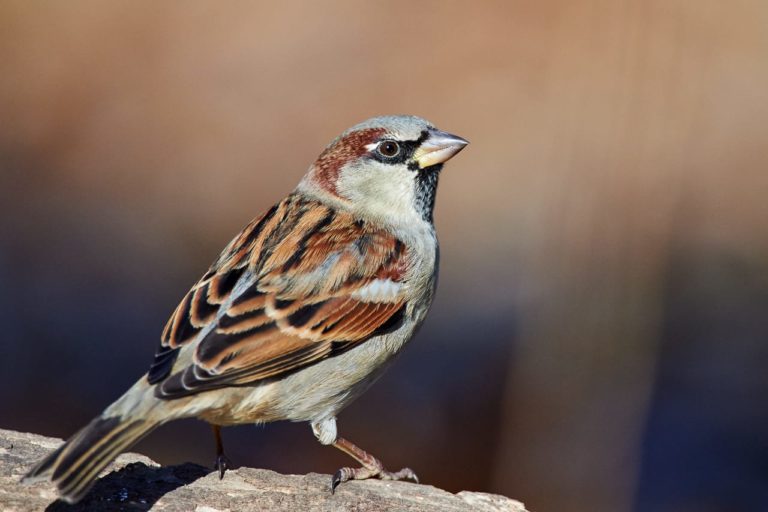
Males have round heads, gray crowns, white cheeks, black bibs, and chestnut necks.
Females are plain buff-brown overall with dingy gray-brown underparts.
Most widely distributed wild bird in the world
Goldfinch
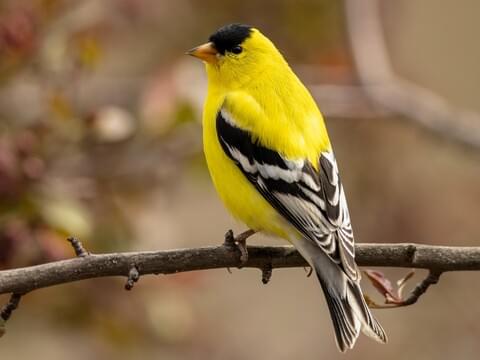
Bright yellow with black forehead, black wings, and white markings.
Females are duller in color than males.
Migrate south for winter. Cannot handle temps below 0 degrees Fahrenheit.
Weave nests tight enough to hold water.
Yellow feathers are due to diet.
Red-Winged Blackbird
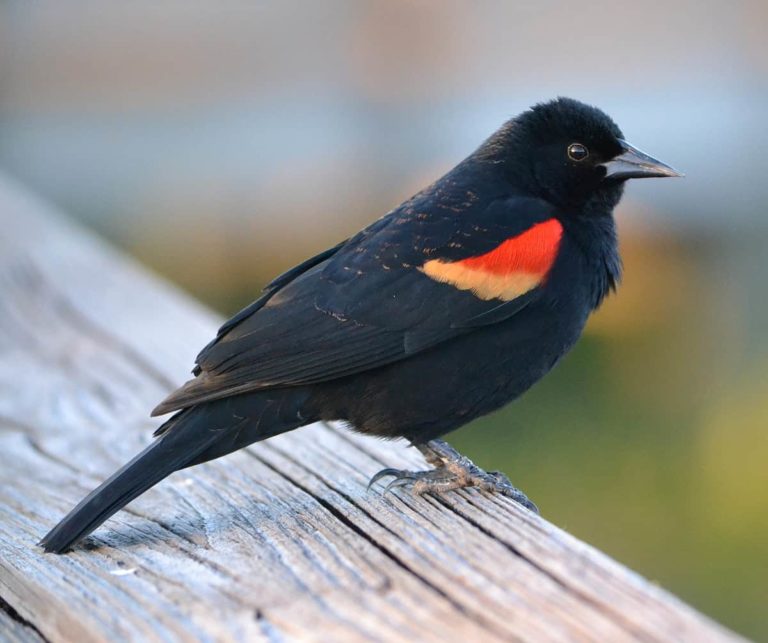
Males are glossy black with red/yellow on their shoulders.
Females are brown and heavily streaked with white (almost checker patterned).
Highly polygamous.
Mourning Doves
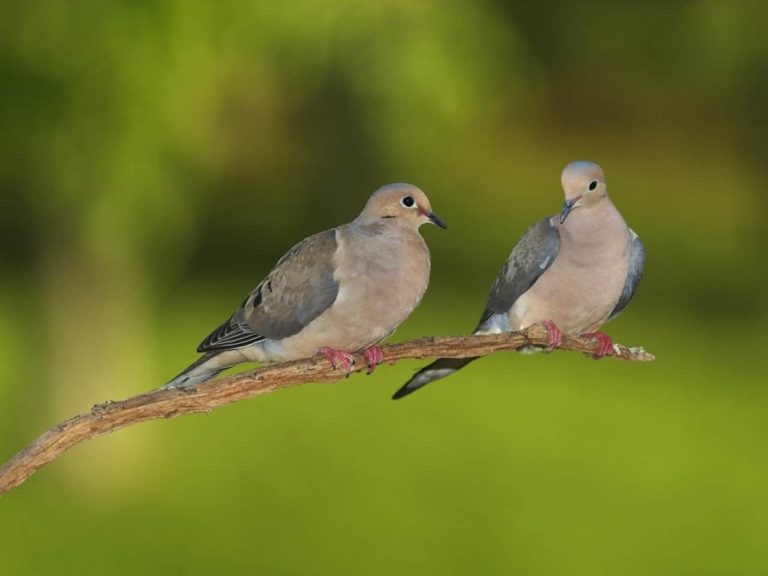
Gray, brown, tan (ish) with black spots on their wings.
Pink legs.
Mate for life.
Drink by sucking.
Carolina Chickadee
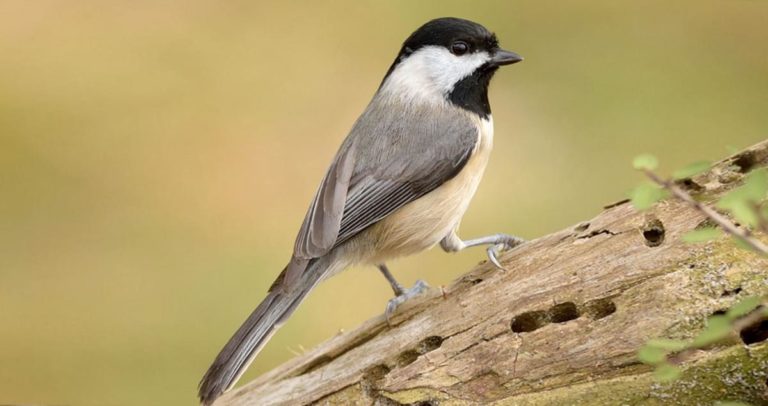
Black head, white cheeks, and gray back, wings, and tail.
Mates for life.
Cavity nester. Will excavate their own nest site in rotten or decayed wood, use an old woodpecker hole, or a nesting box.
Tufted Titmouse
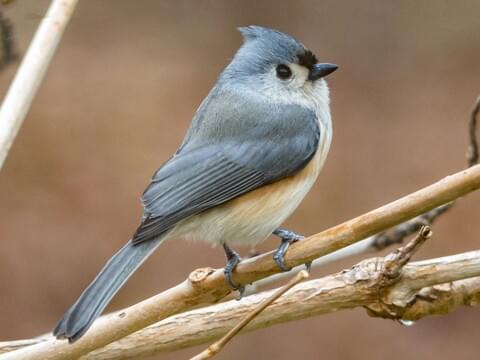
Soft silvery gray on top with white below. A bit of peach coloring down the flanks and a black patch just above the bill.
Uses natural holes in trees, abandoned cavities excavated by woodpeckers, and artificial nesting boxes.
Use its feet to hold a seed while cracking it open.
Average lifespan 2 years.
Blue Jay
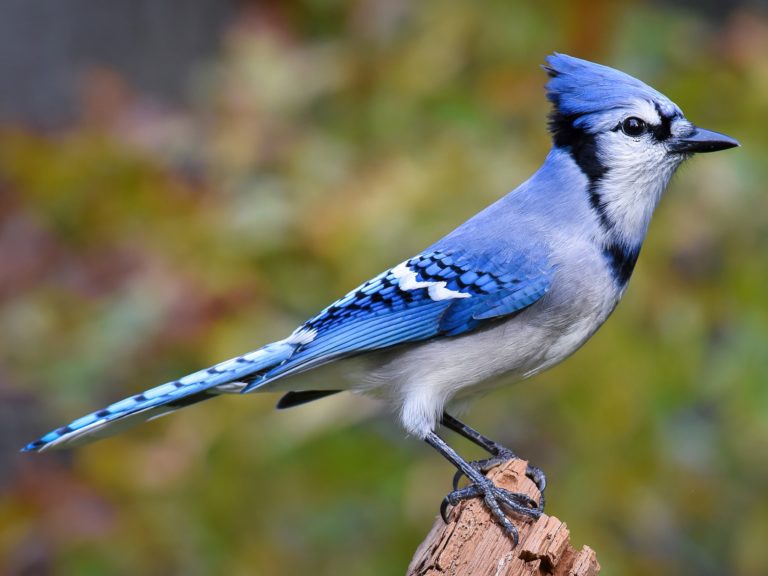
Bright blue on top with a mix of white and gray on throat, chest, and belly.
Love to eat acorns.
Average lifespan 5-7 years.
No states claim the blue jay as their state bird.
Robin
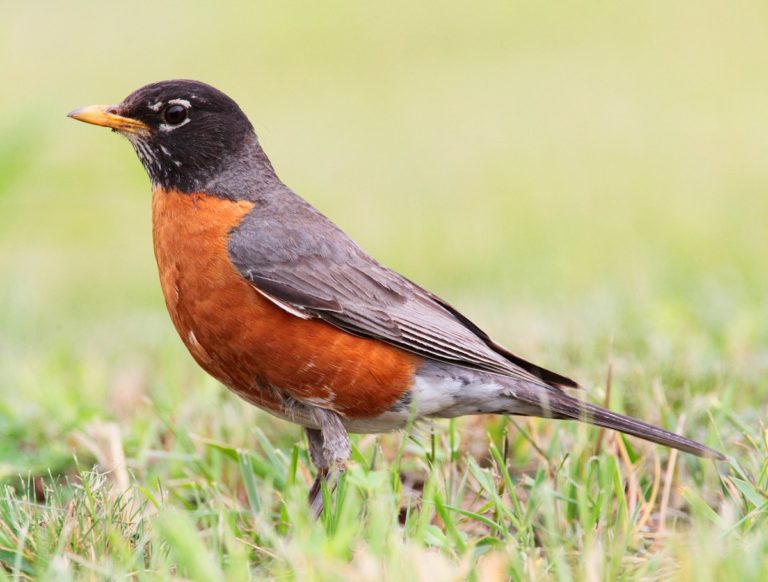
Gray or brown with a red tummy.
Males are more brightly colored than females.
Very territorial. Will fight to the death to defend their area.
Loyal to a food source. The robin you see in your garden is most likely the same one each time.
State bird for 3 states: Connecticut, Michigan, and Wisconsin.
White-Throated Sparrow
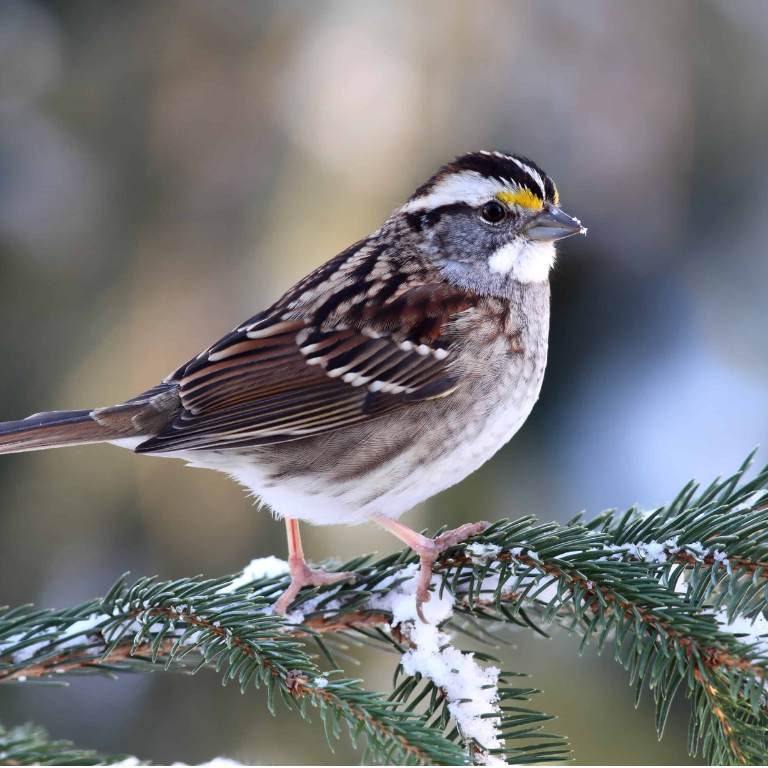
Bright white throat.
Some have brought tan stripes on their head and others have white stripes – they tend to mate with a bird of opposites stripes.
House Finch
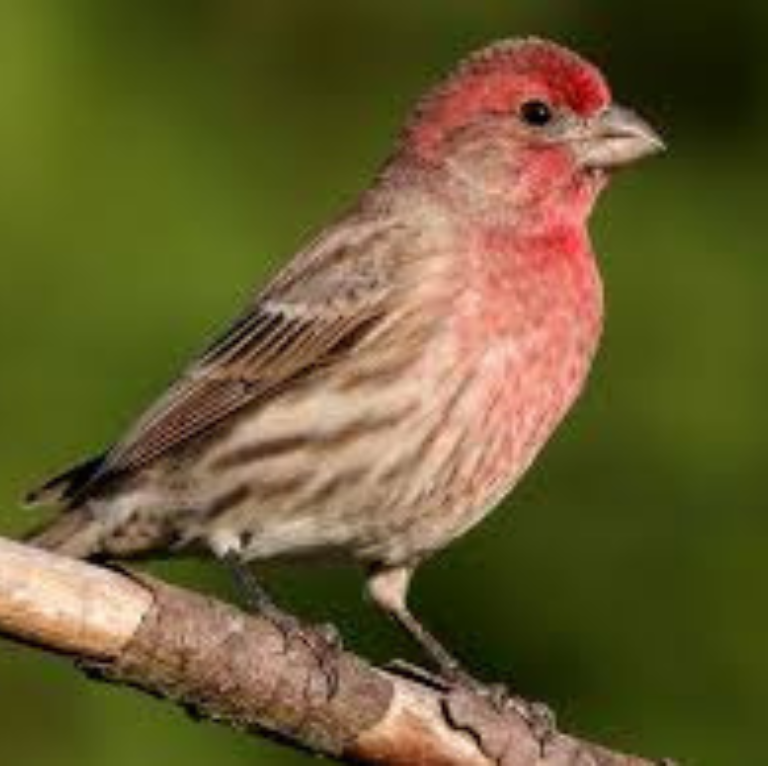
Adult males are red on the face and upper chest.
Females are gray and brown.
In some areas considered an invasive species.
Love water. On hot days can consume more than their own body weight in fluids.
Strict vegetarians.
How to Identify Bird Habitats:
9 Expert Tips for Spotting
Secret Bird Homes
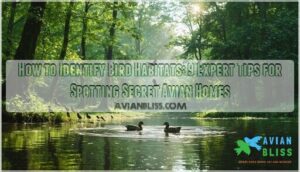
To identify bird habitats, start by observing the environment—forests, wetlands, grasslands, or urban areas all attract different species.
Birds often match their surroundings, so a heron’s long legs signal shallow water, while a woodpecker thrives in tree-filled forests. Pay attention to food sources like berries, seeds, or insects, as these clue you into what birds might visit.
Use tools like range maps or apps like eBird to match species with habitats in your area.
Season matters too—migratory birds may only appear during certain months.
With practice, you’ll start spotting patterns, like how sparrows love open fields while ducks prefer ponds.
Table Of Contents
Key Takeaways
Focus on the habitat’s physical features like vegetation, water sources, and terrain to identify where birds live.
Use tools like range maps and apps like eBird to match bird species with their habitats and seasonal movements.
Pay attention to a bird’s adaptations, such as bill shape or behavior, to understand how it thrives in its specific environment.
Observe food availability and nesting options in the habitat to predict which birds are likely to be present.
Bird Habitat Types
You’ll find birds inhabiting four main habitat types: forested areas with various tree species, aquatic environments like wetlands and shorelines, scrub-shrub zones with dense low vegetation, and open landscapes including grasslands and agricultural fields.
Birds thrive in habitats ranging from lush forests to open grasslands, each tailored to their unique adaptations and survival needs.
Each habitat type supports specific bird species that have evolved adaptations perfectly suited to their environmental niche, making habitat identification your first and most reliable clue when spotting birds in the wild, which is based on understanding their environmental niche.
Forested Habitats
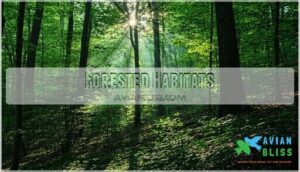
Through forested habitats, you’ll discover distinct layers that support various bird species.
From the understory to the canopy, each level offers unique habitat characteristics.
Forest bird habitat identification relies on recognizing canopy density and edge effects.
You’ll notice that forest fragmentation impacts which species you’ll encounter.
Healthy forest management preserves these essential ecosystems where woodland birds nest, feed, and thrive in their natural environment.
Aquatic Habitats
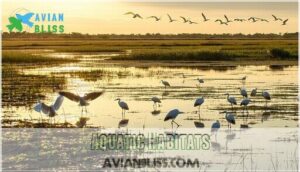
While forests shelter numerous bird species, water attracts an entirely different cast of avian characters.
Aquatic habitats serve as critical environments for waterbirds with specialized adaptations allowing them to thrive where land meets water.
Freshwater marshes host herons, egrets, and rails with their distinctive long legs
Salt marshes and mangroves shelter specialized species like gulls and terns
Coastal shorelines provide feeding grounds for sandpipers and plovers
Estuaries create biodiversity hotspots where freshwater meets saltwater
Open water bodies attract diving birds like loons and grebes
These habitats are essential for the survival of various bird species, and understanding their role in supporting waterbirds and other specialized species is crucial for conservation efforts.
Scrub-Shrub Habitats
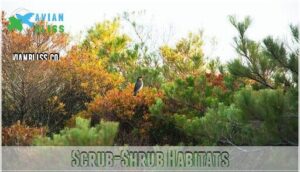
Diversity thrives in scrub-shrub habitats where dense, low-growing vegetation creates perfect hideaways for many bird species.
You’ll find these intermediate ecosystems between forests and open areas, characterized by succession stages of regrowth.
Shrubland birds like towhees and thrashers depend on these habitats for protection and food sources.
Fire ecology often maintains these areas naturally, while edge effects create unique microhabitats where different bird communities overlap.
These areas are threatened by habitat loss and fragmentation.
Open Habitats
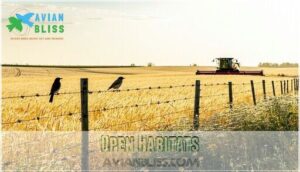
Unlike other habitat types, open habitats attract distinct bird species adapted to life without much vertical cover.
These expansive ecosystems include:
Grasslands where meadowlarks and dickcissels thrive
Agricultural farmland habitats hosting barn swallows and killdeer
Prairie ecosystems supporting grassland specialists like bobolinks
Desert environments where roadrunners and thrashers have adapted
When identifying open habitat characteristics, look for minimal tree cover, abundant grasses, and wide visibility—perfect for birds that prefer scanning their surroundings from ground level, which is a key factor in these expansive ecosystems.
Identifying Bird Habitats
Now that you know the main bird habitat types, recognizing them in the field becomes your next challenge.
When identifying bird habitats, look for key habitat indicators like vegetation structure, water sources, and elevation changes. You’ll want to assess habitat quality through signs of food availability and shelter options.
Remember, microhabitat diversity within larger environments often creates hotspots for specific species. A fallen log in a forest or a small puddle in grasslands can attract birds you might otherwise miss.
Understanding urban green spaces is also essential for spotting avian homes in cities. Learning these subtle cues transforms ordinary landscapes into detailed maps of potential bird homes, making your birdwatching experiences far more rewarding.
Bird Adaptations Found
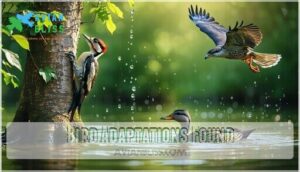
You’ll notice birds have evolved distinctive features that signal their preferred habitats, from webbed feet of waterfowl to the specialized bills of woodpeckers.
These physical and behavioral adaptations aren’t just fascinating evolutionary outcomes—they’re practical clues you can use to identify where certain species make their homes.
Physical Adaptations
When examining birds in their natural settings, you’ll notice their physical adaptations are perfectly suited to their particular habitat.
Birds showcase incredible physical adaptations, each uniquely crafted to thrive in their specific habitats and environmental challenges.
Bill morphology varies dramatically—from the woodpecker’s chisel-like bill to the heron’s spear-shaped one—each designed for specific feeding strategies.
Feet structure, plumage coloration, wing shape, and sensory adaptations are all evolutionary responses to habitat characteristics.
These physical features aren’t random; they’re specialized tools that have developed over millennia to help birds thrive in their ecological niches.
Plumage adaptations, like camouflage for hiding, are essential for survival and have evolved to provide birds with a means to thrive in their environments, making them a key part of the birds’ ability to adapt and hide.
Behavioral Adaptations
Just as birds adapt physically, their behaviors have evolved to thrive in specific environments.
When identifying bird habitats, watch for these behavioral adaptations:
Foraging strategies vary dramatically – woodpeckers drill trees while warblers glean insects from leaves
Social behavior reveals habitat needs through nesting colonies or territorial displays
Predator avoidance techniques like ground-nesting birds feigning injury
Migration patterns that signal seasonal habitat preferences
These behaviors aren’t random – they’re sophisticated adaptations to particular habitat characteristics that help birds survive, and are a result of their ability to thrive in specific environments through particular habitat characteristics.
Habitat Specific Adaptations
The remarkable adaptations birds develop for specific habitats reveal nature’s ingenious design.
They develop unique features such as specialized bill morphology for filtering sediment, or unique feather types that provide insulation.
These features are observed in various species, for example, waterfowl, desert species, forest dwellers, and coastal birds, each with distinct adaptations.
Forest dwellers display leg adaptations for perching, and coastal birds develop sensory adaptations to detect prey under sand.
These habitat-specific characteristics aren’t random—they’re evolutionary responses to their environment’s challenges.
When you understand these dietary specializations, you’ll better appreciate why birds live where they do.
Habitat Based Identification

When identifying birds, start by focusing on their habitat—it’s often the best clue to narrow down your options.
From seasonal shifts to range maps, understanding where a bird lives can help you pinpoint its species with surprising accuracy.
Using Range Maps
Range maps are your secret weapon for identifying bird habitats.
They reveal bird geographic ranges, predict presence, and highlight habitat range overlaps.
To master them:
Study map interpretation keys to decode details like seasonal range shifts.
Check bird range maps to eliminate unlikely species.
Combine maps with observations for precise identification.
Many resources offer detailed avian maps for enthusiasts.
Think of range maps as nature’s GPS for birdwatchers—practical, reliable, and essential!
Seasonal Bird Identification
A bird’s seasonal movements are like nature’s calendar, tied to migration patterns, breeding seasons, and food availability.
During spring and fall, watch for migratory species passing through specific habitats.
In summer, breeding birds settle, while winter reveals species adapted to weather impacts, and molting plumage can also signal a bird season shift.
Time of year shapes bird identification, so stay tuned to seasonal bird movements for better spotting!
Importance of Habitat
A bird’s habitat is its lifeline, offering survival necessities like food, water, and shelter. Understanding bird habitat preferences helps you spot species and grasp their ecosystem health.
Habitat conservation is essential, as it directly impacts species distribution. To identify natural bird habitats, consider:
Habitat characteristics (trees, water, open fields).
Bird behavior (feeding, nesting).
Seasonal shifts.
Bird habitat relationships (how species interact with surroundings).
This understanding of bird habitat relationships and conservation is crucial for maintaining healthy ecosystems and supporting species distribution.
Recognizing Bird Habitats
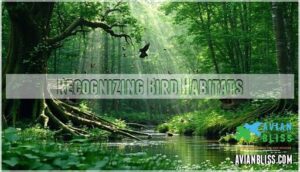
You can spot bird habitats by paying attention to the physical features of the environment, like water sources, tree types, or open fields.
Knowing what species are likely in the area based on habitat clues makes the search much easier, and understanding these complete concepts is key.
Look for Physical Features
Start by observing physical features like vegetation structure, water availability, and soil composition.
Topography clues, such as hills or flatlands, often reveal bird habitat preferences.
Notice microhabitat diversity—small pockets of unique conditions can attract specific species.
These bird habitat characteristics are key for bird habitat identification. Understanding the role of vegetation helps identify specific bird habitats.
By focusing on these details, you’ll master bird identification techniques and spot avian homes hidden in plain sight!
Find Out What You’re Likely to See
Once you’ve noted the physical features of a habitat, think about Habitat Probability.
What birds are likely there based on Bird Range and Seasonal Presence? Local Birds often align with specific bird habitat characteristics and preferences.
Use this birdwatching habitat guide to predict species:
Forests: Thrushes, warblers, woodpeckers.
Wetlands: Herons, egrets, rails.
Grasslands: Sparrows, meadowlarks, kestrels.
Recognizing bird environments sharpens your bird identification skills!
Using EBird for Identification
If you’re curious about bird habitats but unsure what to expect, eBird can be your best ally.
By exploring eBird Data, you’ll access Species Maps, Community Sightings, and even tools like Sound Analysis for bird identification.
It’s a bit like having a birding encyclopedia in your pocket.
Plus, eBird’s Photo ID feature helps confirm your finds, making bird habitat identification easier and more rewarding.
Enthusiasts can also purchase products related to eBird species maps for detailed information.
Frequently Asked Questions (FAQs)
How can you identify seabirds in coastal habitats?
Look for seabirds with webbed feet, waterproof feathers, and salt glands, often gliding over waves or diving for fish.
Their habitats include rocky cliffs, sandy shores, and open water, where they thrive in saltwater environments.
How do I identify birds by habitat and range?
To identify birds by habitat and range, focus on where they live—forests, wetlands, or grasslands—and use range maps to check their seasonal movements.
Habitat clues, like vegetation or water, narrow possibilities quickly, and using range maps can be particularly helpful in this process.
How can you identify a bird?
You don’t need to be an expert to identify a bird—focus on its size, shape, color patterns, and behavior.
Listen for calls, observe its habitat, and use range maps for clues.
How do I find a bird in my area?
Start by exploring local parks, backyards, or nature trails.
Birds often hang out where food, water, and shelter are abundant.
Use binoculars, listen for calls, and check trees, shrubs, or open spaces.
How do I find a bird’s habitat?
Imagine birds as picky travelers—they choose spots offering food, water, shelter, and nesting.
Study the landscape: forests, wetlands, or grasslands.
Match bird behaviors and physical traits to the habitat’s unique features, considering complete concepts that influence their decisions.
What should you observe in a bird’s habitat?
Watch for vegetation types, water sources, and terrain features.
Notice food availability, nesting spots, and shelter options.
Pay attention to weather and season, as these influence bird presence. It’s like reading nature’s blueprint, which involves understanding the complete concepts of the environment.
What are the 4 keys to identifying birds?
To identify birds, focus on size and shape, color patterns, behavior, and habitat.
Think of these as your "field guide keys" to reveal clues, narrowing down species and making each sighting more meaningful.
What are the habitats of birds?
Over 10,000 bird species thrive worldwide, each tied to unique habitats like forests, wetlands, grasslands, coasts, and mountains.
These environments provide essentials—food, water, shelter, and nesting—perfectly matching their adaptations and survival needs, especially in terms of unique habitats.
How do I know what birds are in my area?
Check local birding guides or apps to find species common in your area.
Pay attention to habitats like forests, wetlands, or urban spaces nearby, and use seasonal migration patterns to narrow down possibilities.
Is there a free app that identifies birds?
Over 70 million Americans enjoy birdwatching, and apps like Merlin Bird ID are free and fantastic.
Just upload a photo or describe the bird, and it’ll help you identify species based on location and traits.
Conclusion
Spotting bird habitats is like solving a nature puzzle—each clue, from a heron’s long legs to a sparrow’s field preference, reveals their secret homes.
By observing landscapes, food sources, and seasonal patterns, you’ll sharpen your skills in how to identify bird habitats.
Don’t forget tools like eBird and range maps, which simplify the process.
With practice, you’ll decode these avian mysteries, turning every walk into an adventure filled with discovery and connection to the natural world.
Try Birding After Dark
It can be a challenge, but it can also be highly rewarding.
Think a Snowy Owl is impressive in the daylight? Wait until you spot their ghostly figure at night. Photo: Ryan Pennesi/Audubon photography Awards
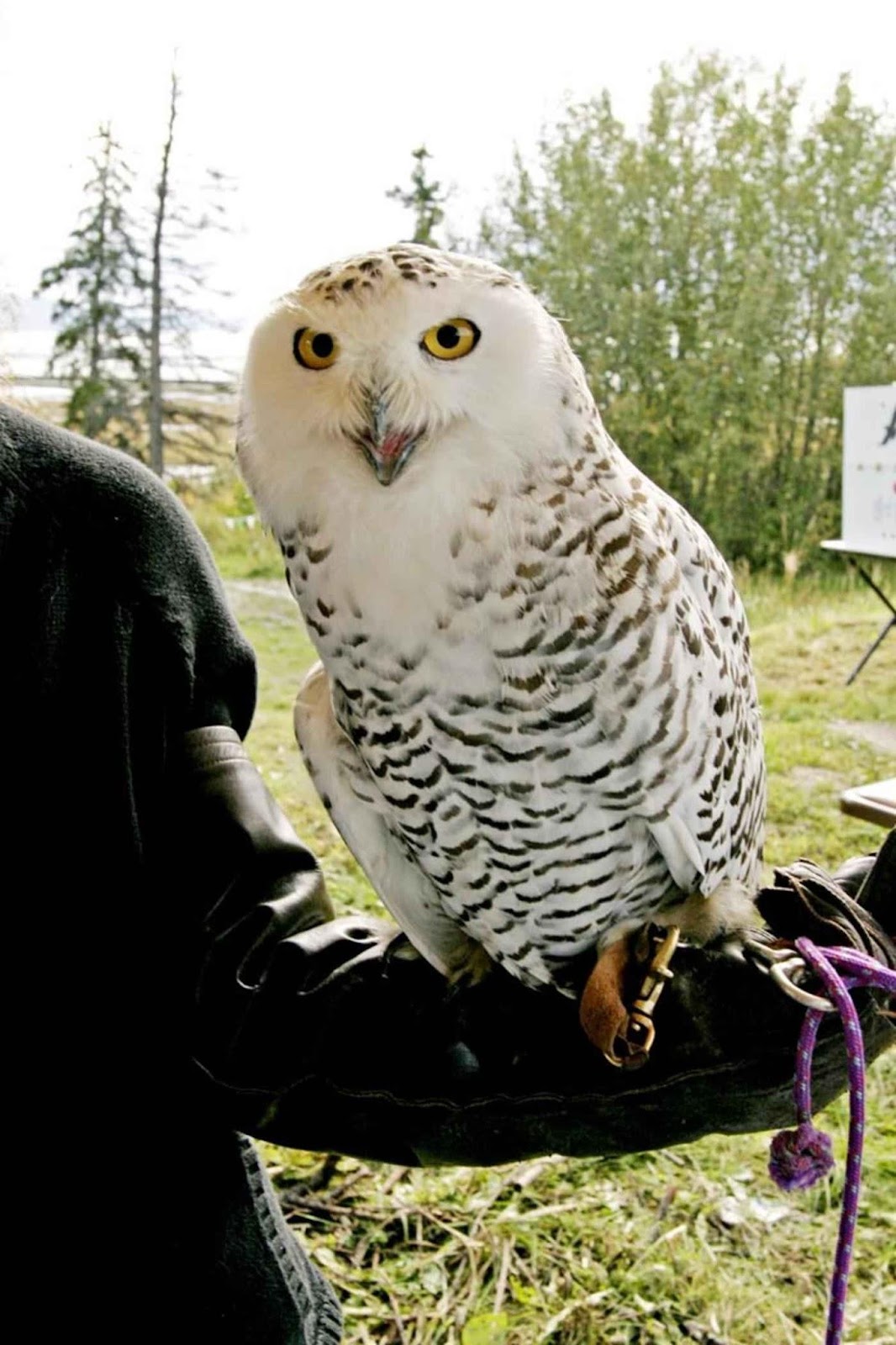
Getting up super early in the morning is an uncomfortable requirement for many birders. But we’re told that you’ve got to get out at dawn if you want to hear the birds singing, and so we leave our warm beds and drag ourselves out into the predawn darkness. Early birds get the worms, but early birders get the birds.
I’m sure some birders out there love getting up before dawn, but I don’t. And I know plenty of others who don’t either. But what if there was another way? What if you could still be an excellent birder while sleeping all morning long? Well, if you’ve read the headline to this article, you’ll know that there is a way: bird after dark.
Birding at night is a much different experience than birding during the day. Mostly because, you know, you can’t see anything. You’ll never see as many species as you will during the day, but it’s a new way to experience birdlife. You’re out there looking and listening for species you don’t really go after during the daytime, and you’re developing new birding senses. It can be extremely rewarding.
Owls are a favorite prize. Owls! I don’t appreciate them enough. They’re ninjas of the bird world, silently stalking their prey under cover of night. Fortunately, they’re not always silent, and getting out at dark to listen for calling owls is the most common nighttime-birding activity.
How does a beginning birder start owling? It’s as easy or as challenging as you want it to be. Start by figuring out what owls live near you and what their calls sound like. Audubon has a good primer on common owl calls, and you can also check the incredible Xeno-canto for pretty much every other call you would ever need.
Once you know what you’re listening for, head to some woods. Owls generally breed earlier than other birds, so they’re actively hooting when many other birds are silent. For example, Great Horned Owls and Barred Owls nest as early as December and can be heard hooting through the fall and winter. So, what I'm saying is, go out there now.
You can check eBird for owl sightings nearby, or you can just find a patch of woods and start hooting yourself. You might be surprised to get a response! Believe me, the sensation you feel when you first hear an owl hooting off in the darkness—especially if it’s closer than you expected—is something you’ll never forget. (Don’t play tapes though, please, especially during nesting season.) Also, make sure to bring a flashlight, both so you can try to spot the owl if its close and also so you can see where you're going.
Owls aren’t the only birds calling at night, of course. There are other species that you’re unlikely to see during the day and are best heard after dark: the cooly-named nightjars, also known by the even cooler name goatsuckers. (Quick aside: They were originally referred to as goatsuckers because of they’re weird looking, and people long ago thought that they came into pens at night and drank milk from goats. They don’t.) This group includes whip-poor-wills, Chuck-will's-widows, nighthawks, Common Poorwill, pauraque, and more. For the most part, each of these birds stays largely motionless and perfectly camouflaged during the day, but they can really raise a ruckus at night. NIghtjars aren’t around during the winter in most of the U.S., so you’ll have to go out during late spring and early summer to hear them singing. I highly recommend it.
Looking to get more intense? I’ve got something for you: night flight calls. Known as NFC by dedicated birders, this is the practice of listening for (or recording) the short calls of birds as they migrate overhead in the middle of the night. It’s intense. As hundreds of species migrate in the spring and fall, they make little calls to each other, presumably to stay in touch up there in the dark. Really good birders—like, REALLY good birders—have learned to differentiate those little calls and identify them to species. Some will even record an entire night’s worth of NFCs and then analyze the information on a computer, getting a more accurate picture of migration.
I have never listened for NFCs. It’s honestly hard enough for me to remember the freaking songs of these birds during the day, let alone the tiny little notes they make in the middle of the night thousands of feet overhead. One day I’ll get there, though. If you want to get started before me, here are some helpfulresources.
Another nighttime option after you get some experience is a Big Night. An insomniac’s version of a Big Day, a Big Night is exactly what it sounds like: Birders have to identify as many species as they can from sunset to sunup. Not many birders have done a Big Night (actually, I really only know of the one linked above), so it might be your opportunity to set a record. Make your mark—at night!
Birding at night is fun, but stay safe, you know? All the precautions you might take for birding during the day—letting people know where you’re going, not going by yourself—apply doubly during the night, when you can more easily get turned around in the woods or run into a shady stranger. I wish I had better advice for this part, but I don’t really know what to say other than keep your wits about you, and be careful.
Then, when you’re home, feel free to sleep in.
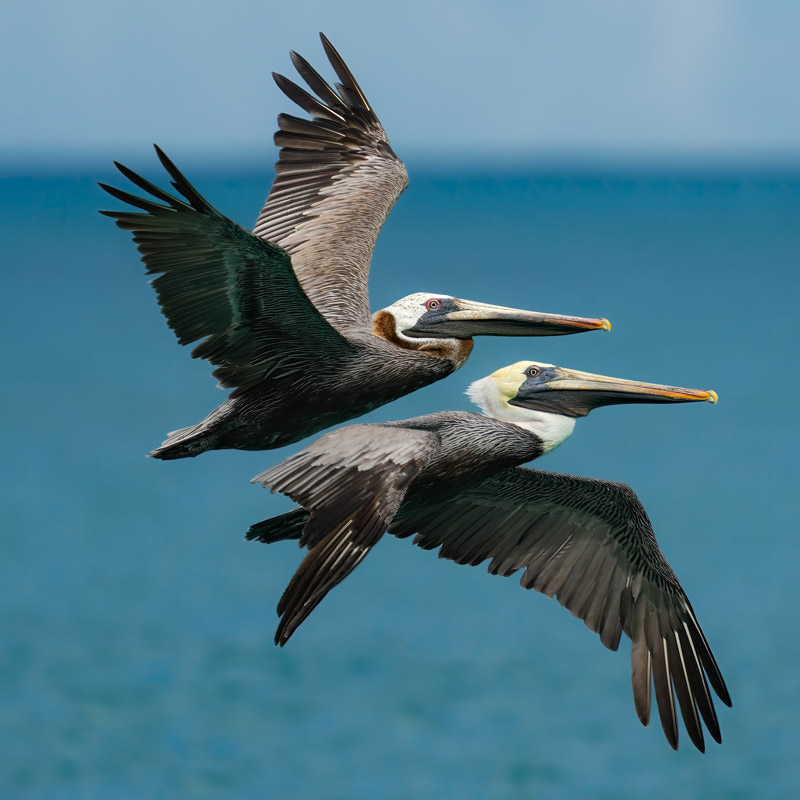
50+ Incredible Activities for Little Bird Watchers
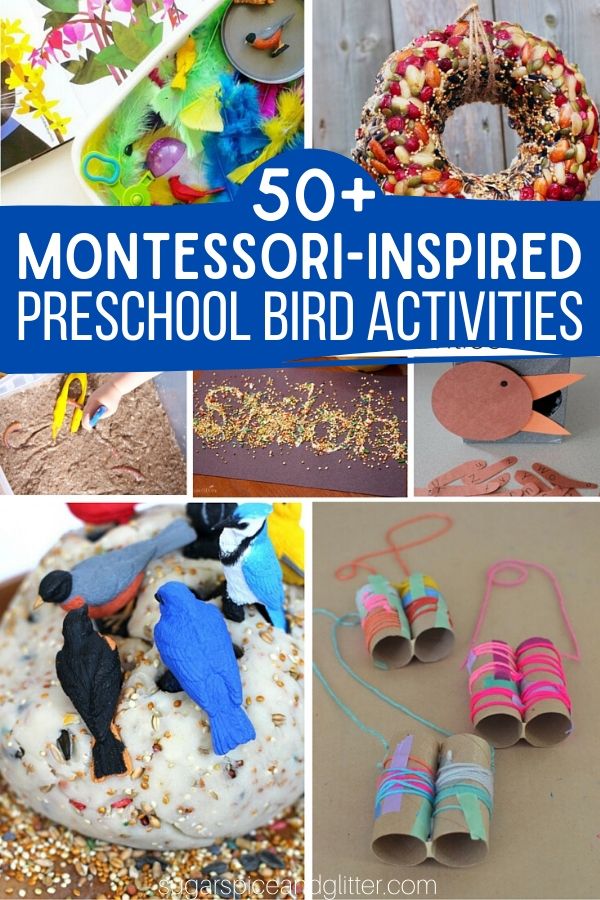
I’ll be fully honest: at this point in our life, we’re not strictly Montessori. Ella attends a Reggio kindergarten part-time, and with free full-day kindergarten starting at 3.5-4 years old in Canada, our daycare kids are all between the ages of 1-3. I would say we are still heavily Montessori-inspired because that’s my background and what we love, but our activities look different than what you would see at a Montessori school.
Play Video
While there are “all or nothing” Montessori purists, I’d rather implement what works in our lifestyle and not try to fit our lifestyle into a strict definition of what it means to be Montessori. If Montessori means hands-on learning, child-based inquiry informed by the teachings of Dr. Maria Montessori, I would say we’re pretty Montessori!
I’m going to break down these ideas into their Montessori Categories – Sensorial, Practical Life, Language Arts, Math, and Culture.
You can see our Jolly Phonics-inspired /b/ is for bird (mini) unit study here.
One material you’re going to see over and over again in these activities are these Bird Toobs from Safari Ltd. They have a Backyard Birds collection and an Exotic Birds collection. I like them because they are very detailed and realistic – more so than any other similar collection of miniature animal figurines we’ve checked out. The figurines are individually hand painted and super affordable, and ours have lasted nearly a decade without any visible signs of wear.
Also, be sure to provide a few books about birds in your reading nook while engaging in your bird unit study. I’ve collected my favorite Montessori-inspired Bird Books here.
Don’t forget to grab our free printable unit study planners here.
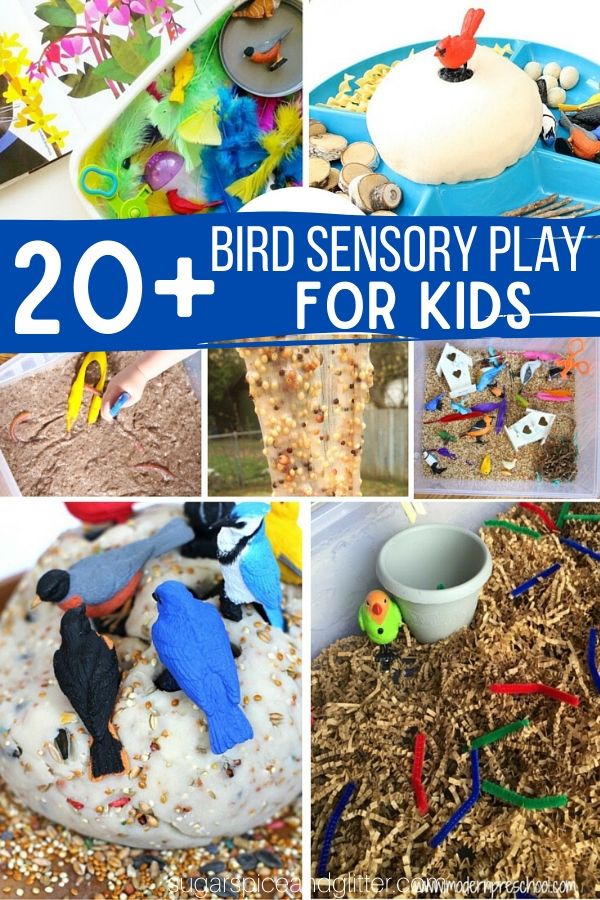
Bird Sensory Play
In Montessori, the Sensorial curriculum is not the same as your typical sensory play – but sensory play can be a more accessible way to engage the senses if you can’t buy or DIY the whole sensorial curriculum.
Sensory Play is always a huge part of our curriculum, and it’s essential in any well-rounded preschool program. We’ve done quite a few bird sensory activities this Spring and I’ve found a few more ideas we’d like to try! We also included some bird-inspired sensory play ideas in our 10+ Spring Sensory Bins post.
Bird Seed Sensory Bin
Feather Painting | Munchkins & MomsProcess art & sensory, all in one!
Bird Binoculars | Art Bar Blog
Make these binoculars and then focus on observing & isolating your sense of sight while looking for birdsSpaghetti Birds Nests | Still Playing School
Kiddie Pool Bird’s Nest | Creekside Learning
Bird Seed Play Dough | Two-daloo
Bird Nest Play Dough Invitation | Fantastic Fun & Learning
Feed the Birds Fine Motor Sensory Bin | Modern Preschool
Play Dough Birds | Craftulate
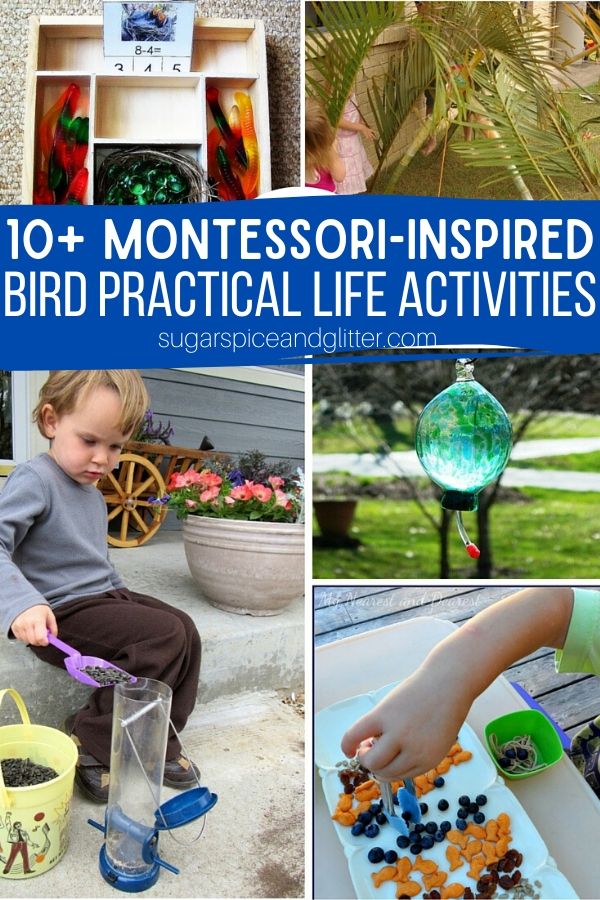
Bird Practical Life
There are lots of fun ways to incorporate a love of birds into your child’s Montessori practical life activities, from making bird feeders to making a meal with eggs! Here are a few ideas to get the ball rolling:
Build a bird feeder
We’ve made several – cookie cutter ones, peanut butter on a tp roll versions, and Cheerios on pipe cleaners, etc.Bird a Bird House
Feathers for Lunch | Munchkins & Moms
This activity might look like sensory play, but it also incorporates scissors skills and hand-eye coordination – which I would say are pretty practical!Cleaning Bird Feeders | from Marie of Child Led Life
Filling Bird Feeders | Mama’s Happy Hive
Part of a larger toddler bird unit study.Eat Like a Bird | My Nearest & Dearest
Use some tongs to practice fine motor skills and pretend that you’re a bird gathering food with it’s beak!Transferring Eggs | Every Star is Different
If you’d prefer a non-food activity with your tongs, this egg transfer activity is a great way to put that devilled egg tray to good use!Studying Bird Beaks | Pink Stripey Socks
Another twist, but I really love this concept of using several different utensils to recreate the function of a beak – and I REALLY how Leslie painted her son’s hand to look like a bird with the fingers as the beak!Building a Bird Hide | Mother Natured
While building a bird house would be fun, what about building a jungle-style “bird hide” that kids can observe & photograph birds from!Egg Cracking Fine Motor Activity | Modern Preschool
Maybe not what you’d expect from the title – but a great way to build some hand muscles!Our PB&J Bird Seed Ornaments are also a great way to use practical life skills in the kitchen (and then get to see all of the birds visiting to enjoy their special snack).
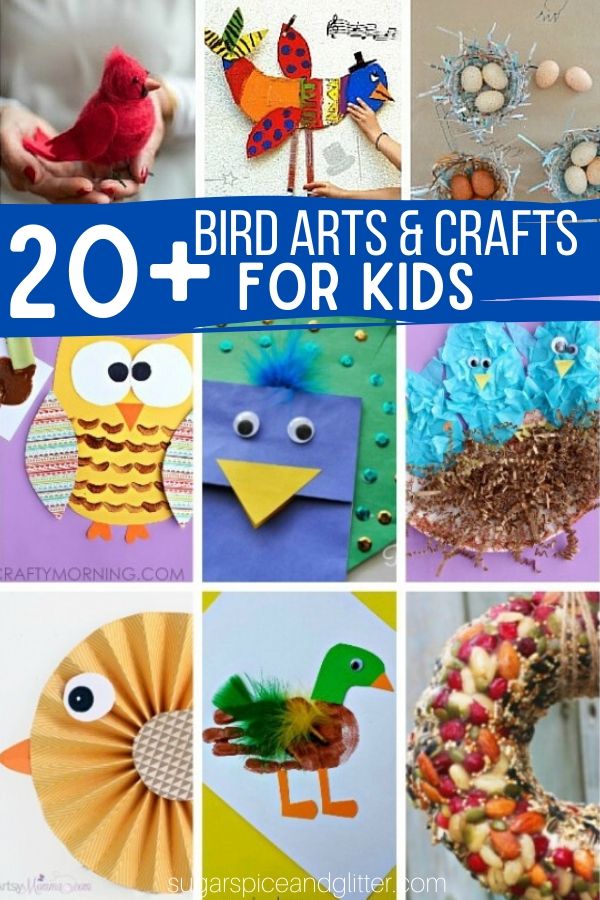
Bird Language Arts
We previously shared our Top 10 Bird Books (a mix of fiction and nonfiction), and here are some other ways to include birds into your language studies:
I love coming up with fun ways to change up our Montessori Writing Tray, like adding bird seed instead of salt/sand!
Magnetic Bird Letter Activities | Learning2Walk
You can keep them on a cookie sheet if you don’t want them decorating your fridge.Bird 3-Part CardsOfficially a science material, but they are also good for learning to read
Printable Bird I Spy | And Next Comes L
A great way to practice descriptive language and adjectives to describe the various birds on the printableBird Consonant Blend Activities | Learning2Walk
Seed Name Art | Life Over C’s
Create a beautiful, textured name for children to trace and admireFree Spring Bird Emergent Reader | Early Learning Ideas @ Teachers Pay Teachers
Bird Alphabet Poster | Yong Chen
I am loving this & think it would work well with the other bird art in our play room.Letter Crafts | Mommas Fun World
I love Orton-Gillingham crafts, like the letters D and N from this series, as well as a “B” decorated like a bird.Feed Letter Worms to the Baby Bird | Kiwi Krate
Our Easy Bird Feeder is also a great science-meets-art activity!
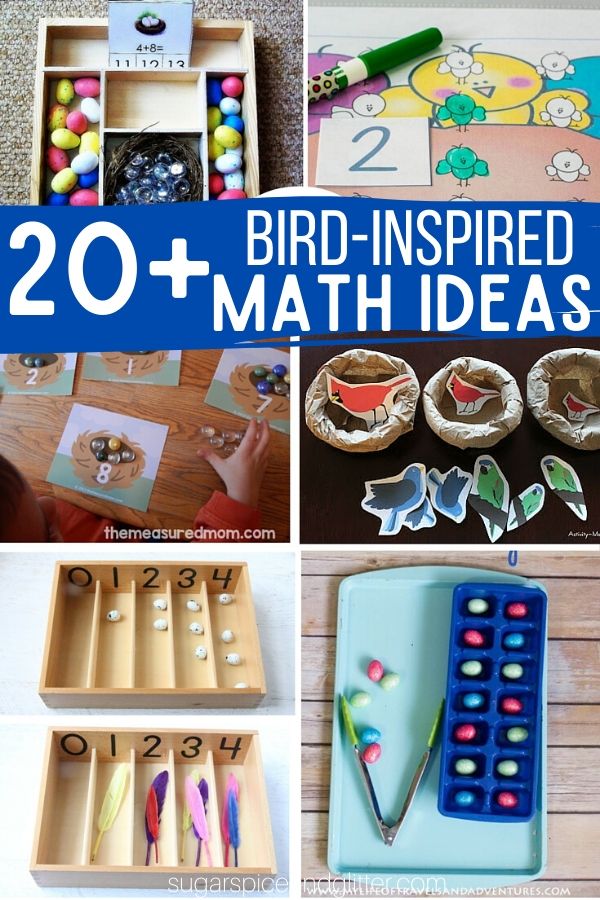
Bird Math
Replace the spindles in your Montessori Spindle Box with craft eggs or fishing tackle worms.
Bird Play Dough Mats for Counting | Life Over C’s
A fun way to blend sensory play and math!Counting & Subtracting Bird Eggs | Every Star is Different
This post also has a printable set of 50 Bird Cards from around the world!Bird Sorting | Activity Mom
Practice size classification with this free printable & some easy paper bag nests!Nest Counting Mats | the Measured Mom
Robin’s Next Addition | Make Take Teach at Teachers Pay Teachers
Pin the Tail on the Bird | From Pond
I love how many ways to play Mel came up with!Fingerprint Nest Eggs | Adventures in Tutoring & Special Education
You could use children’s fingers or bingo dabbers to complete these counting sheets.Egg Sorting Tot Tray | My Life of Travels & Adventures
This is a great way to practice one-to-one correspondence combined with practical life & fine motor skills!5 Little Ducks | the Wiggles
I love finger play songs, and this one is a classic that involves 5 little ducks going over a hill and far away…
Bird Culture
In Montessori, “culture” refers to science, sociology, geography, and history. Here you will find an assortment of ideas that range from scientific observation and experiments, to understanding the anatomy of birds, and the different birds that can be found all over the world!
Bird Watching | Kitchen Counter Chronicles
Go for a nature walk and look for birds – binoculars and bird guide book optional!PB&J Cookie Cutter Bird Seed Ornaments
A bit of sensory play, kitchen time and bird culture all in one!Backyard Birds Observation sheet | Natural Beach Living
A more localized approach to bird watching, which is perfect if you just set up a special bird feeder.Invitation to Build a Bird’s Nest | Munchkins & Moms
A great sorting and classifying activity.Bird Next Provocation | Wonders in Kindergarten
Go for a nature walk and then set-up this hands-on exploration of how to build a bird’s nest.Bird 3 Part Cards & classification book printables | the Pinay Homeschooler
Learn the parts of the bird & make your own book with these free printables.Studying Bird Characteristics | the Pinay Homeschooler
Bird Beak Experiment | Blessed Beyond a Doubt
After you notice that not all beaks look the same, it might be a good time to explore the different uses for beaks! Beaks are so much more than lips – they are tools that birds can use in many different ways.This Bird Life Cycle set is on our wishlist!
Predict & Pour Bird Seed | Familylicious
We love using our bird cards with our Montessori bird puzzle to practice fine motor skills & learn the parts of the bird, at the same time!
Be Sure to Pin this Collection of Bird-inspired Activities for Kids!
Are your kids interested in birds? What kind of bird activities would you add to this collection?
Check out these other Montessori Nature-inspired ideas from my fellow Montessori bloggers as part of the 12 Months of Montessori Blog Hop:
Exploring our Senses Outdoors (Montessori Silence Game) – Printables | The Natural Homeschool
Montessori Nature Tray with Vocabulary – Parts of the Plant | Living Montessori Now
Montessori Inspired Bird Unit – Mama’s Happy Hive
College Application Essay Writer
Montessori-inspired Backyard Bird Activities | Every Star is Different
Nature in the Field | Grace and Green Pastures
Transforming your backyard into a bird-friendly sanctuary is easier than it seems. With the right plants, feeders, water sources, and shelter, you can create a space that not only benefits birds but also brings beauty and life to your garden.
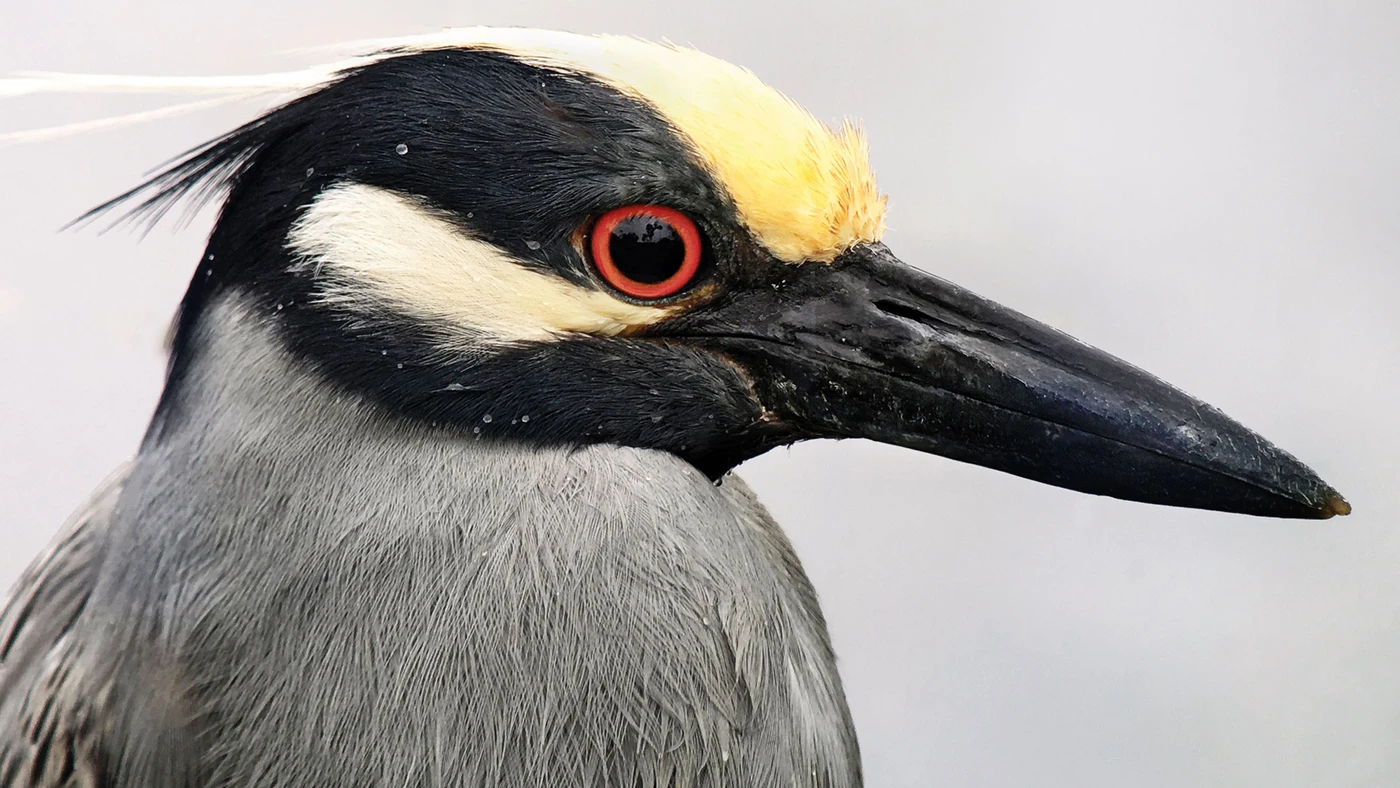
How to Photograph Birds With a Smartphone
April 21, 2016 — You already own a powerful tool for snapping birds. Here’s how to make the most of it.
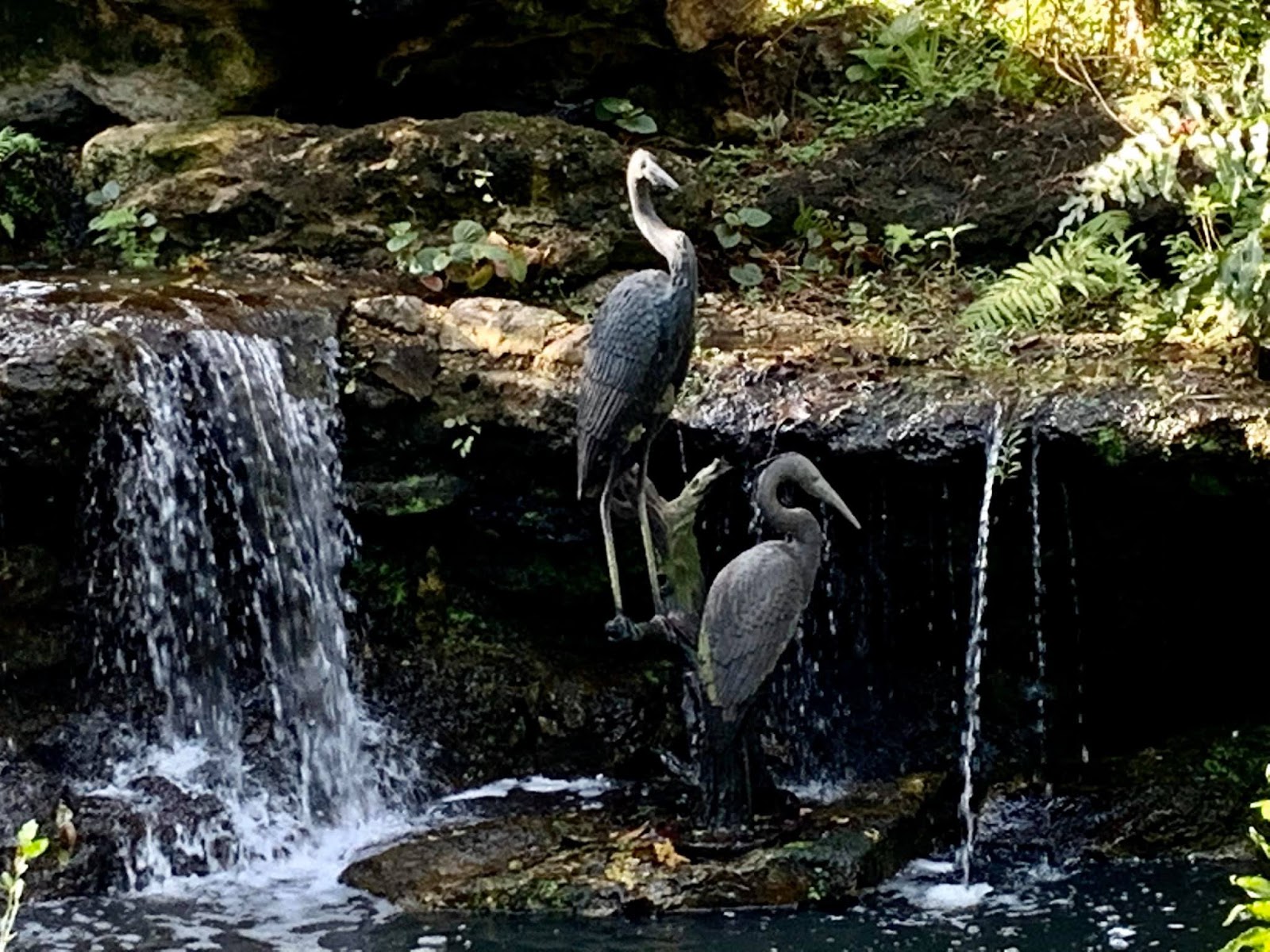
10 Tips for Photographing Birds
January 16, 2014 — A professional photographer, and past Audubon Magazine Photo Awards winner, offers advice for capturing stunning bird shots.
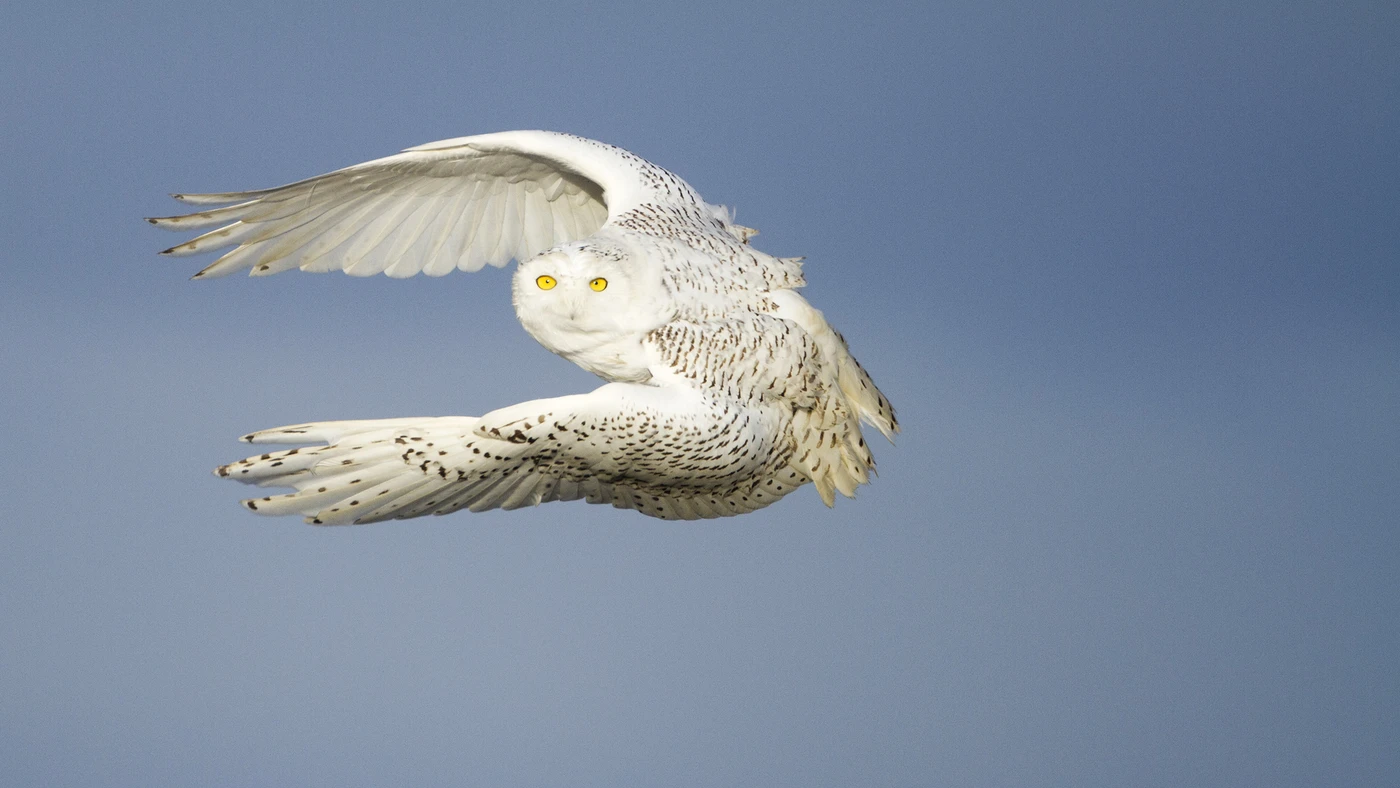
Six Tips for Photographing Birds from Boats
June 05, 2018 — For stunning shots of alcids and other ocean-loving species, get in their element.
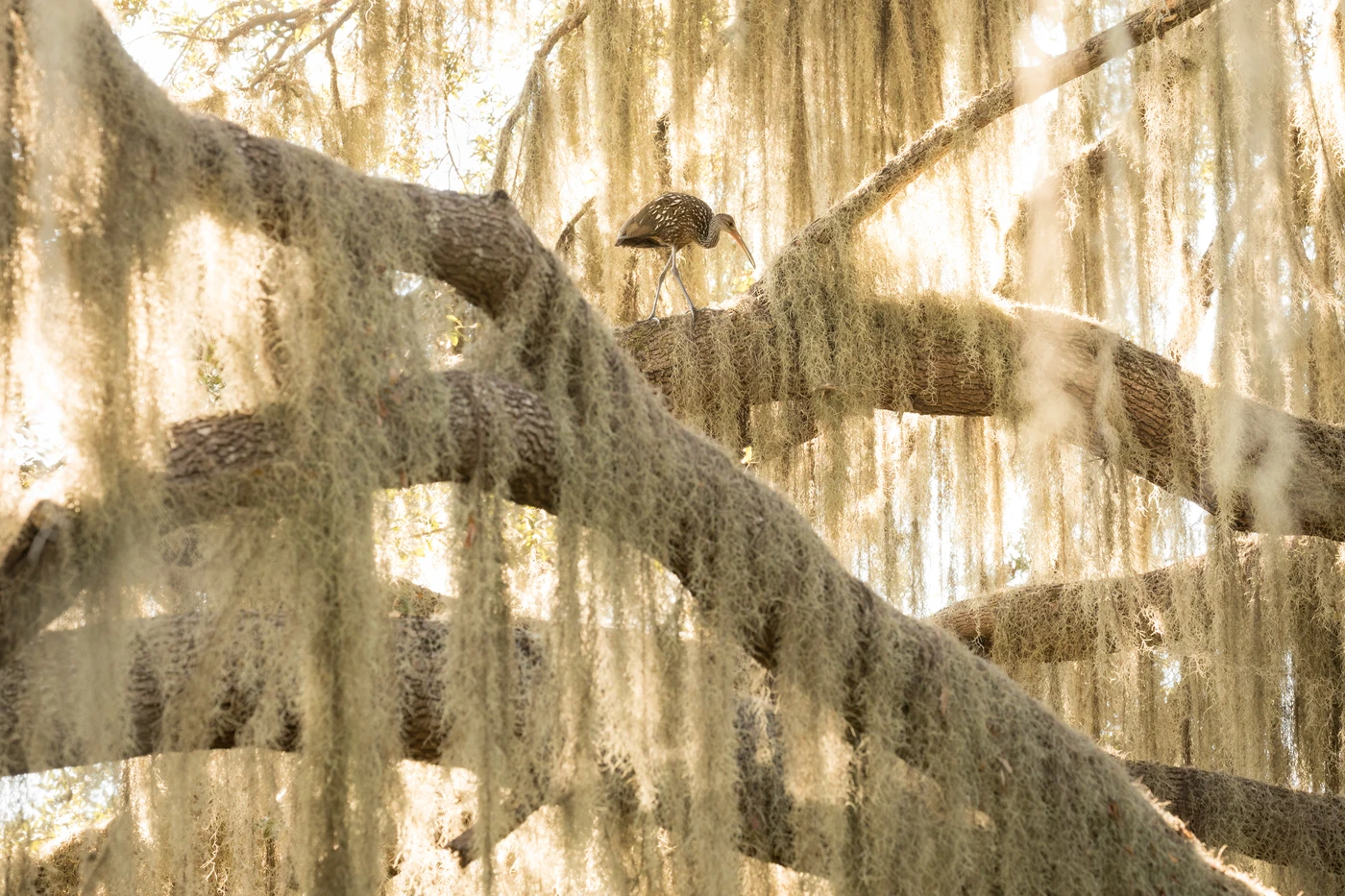
Zoom Out: Tips for Photographing Birds in their Landscapes
Put down the telephoto lens, and you might just enhance your art.
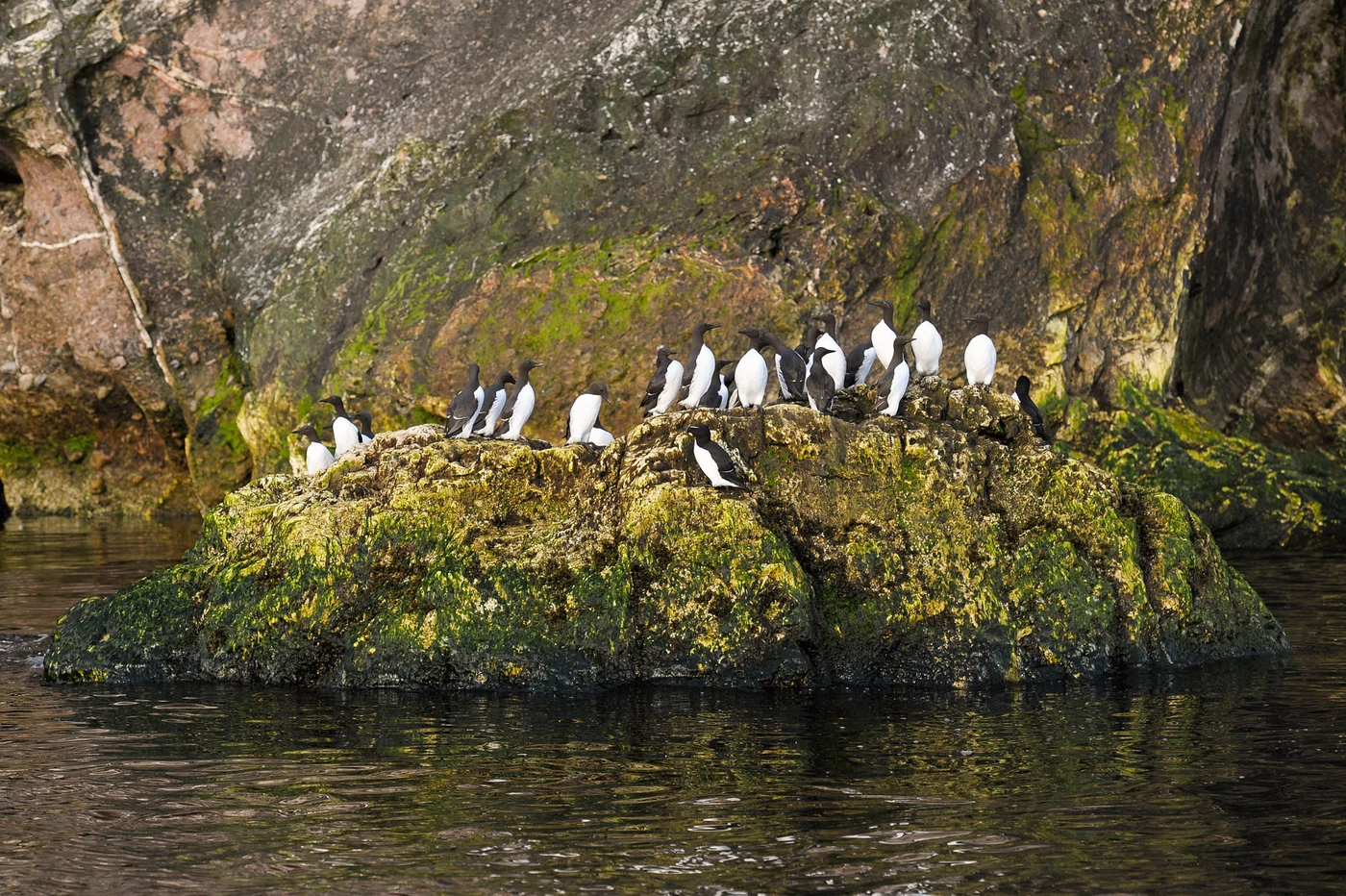
Photographing Birds From a Boat:
A Guide to the Basics
For a whole new perspective, try a trip where you float.
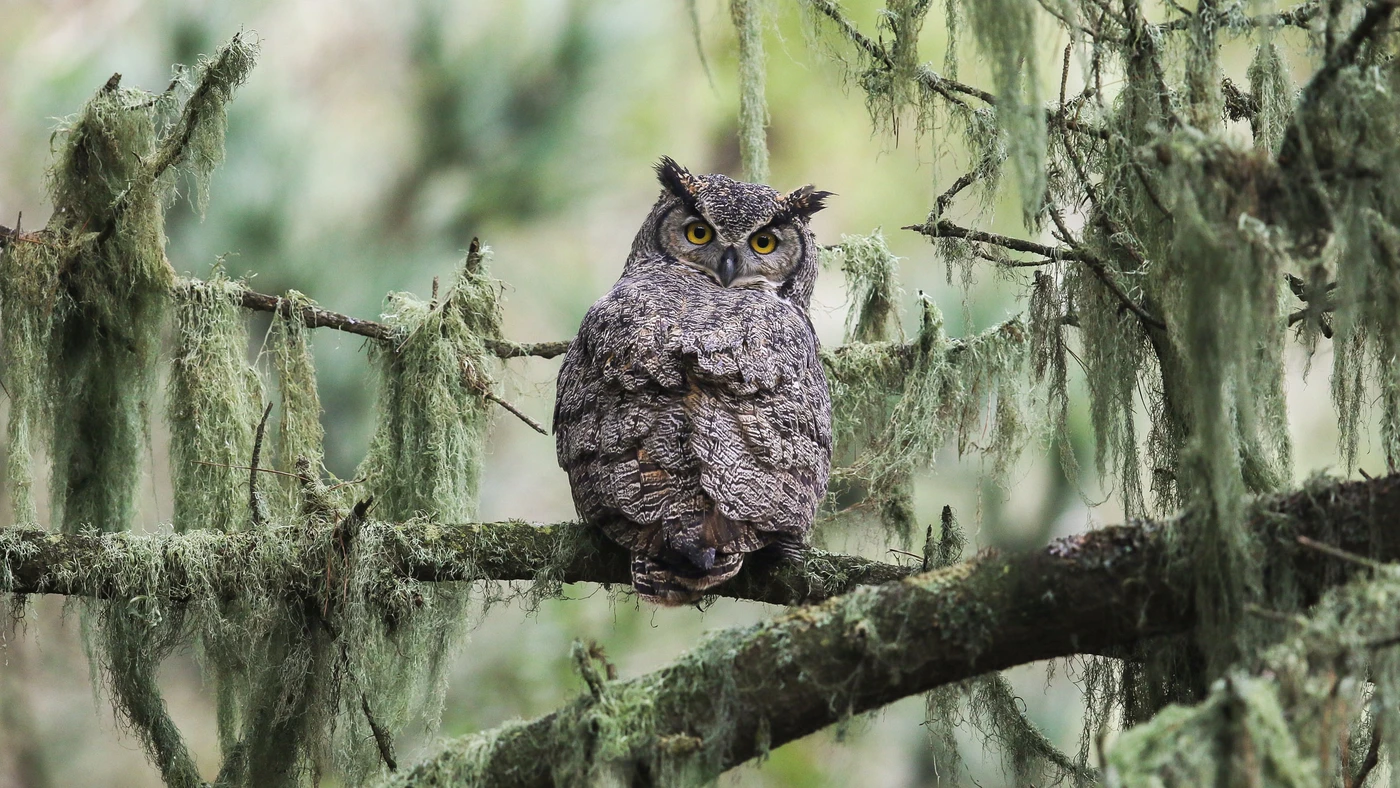
How to Get the Right Exposure for Photographing Birds
July 07, 2016 — Mastering basic DSLR techniques like f-stops and shutter speeds will make your images stand out.

Why Closer Is Not Always Better When Photographing Birds
February 03, 2017 — The impulse to shoot your subject at close range can be powerful, but there are several reasons why that's not best for the animal—or the image.
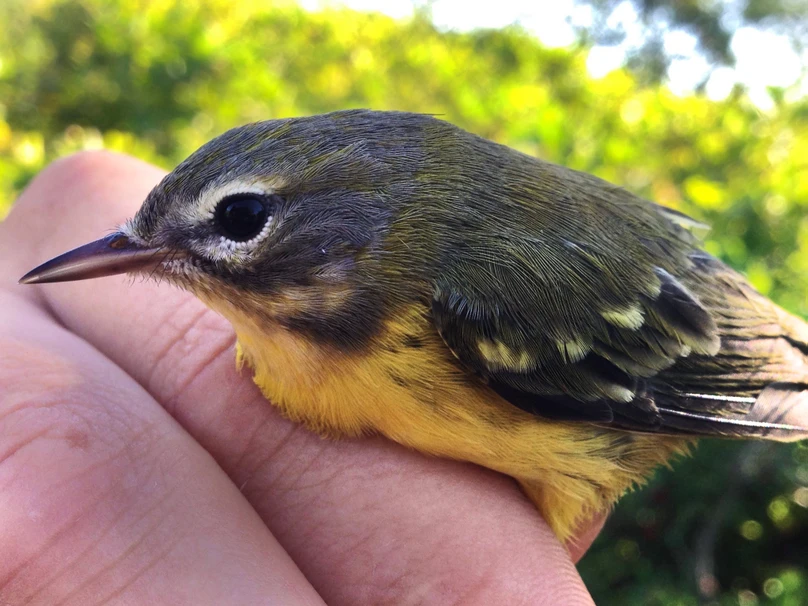
10 Ways to Take Better Smartphone Photos
How to make the most out of the camera that you always have with you.
How to Share Your Kids’ Photographs
These apps, tools, and tips will connect your budding photographer to a broader community of bird enthusiasts.
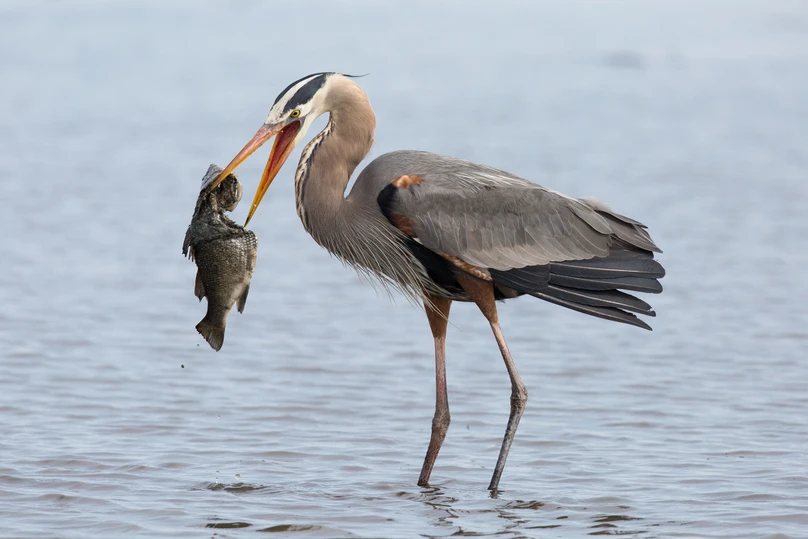
Maybe your child took some great shots of neotropical migrants during your family birding vacation in Costa Rica. Or she’s successfully captured the story of the robins hatching and fledging in your backyard. What do you do with the photos now, so that they don't fade into obscurity on your home computer? Here are some ways to preserve and present them, either to your friends and family or to the broader community or birding world.
Preserve for Friends and Family
Print and frame the favorites. You can do this on a home printer using photo paper, or order prints in any size from an online service. Or you can turn a particularly vibrant image into something even more creative. The website Big Huge Labs lets you design all kinds of products, such as trading cards, jigsaw puzzles, and magazine covers (you can produce your own Audubon cover!).
Kodak Fun for Kids features DIY projects, such as a memory card game, that parents and children can make together using printed photos. Along with instructions, the site lists suggested skill levels, materials needed, and time requirements.
Share With Your Local Community
If your child has photos that tell the story of a birding trip, or a portfolio of images of local birds that they're excited about sharing with others, consider encouraging him or her to put together a slideshow. Google Slides is free to use and fairly intuitive. Venues such as a local school, public library, or Audubon chapter will likely welcome the presentation and provide the projector and screen.
Alternately, Animoto enables you to turn photos and video clips into stunning HD videos; you can even set them to music. Smilebox offers another way to create animated slideshows (and greeting cards, too). Your creations can then be emailed, posted to Facebook, or burned onto DVDs. Both sites offer a free trial period if you want to check them out before purchasing a year’s subscription.
Consider putting together a photo display that could be mounted at a local community center or as part of an event, like an Earth Day celebration. Are there nature centers in your area that could use photos to promote education and awareness about local wildlife?
Establish a school photography club to help your child and others link up to share their photos. Inquire at the school to see if there’s interest; the art teacher is often a good place to start. eBird also offers some tips on How to Start a New Club. Though aimed expressly at birding, its “Young Birders Club Toolkit” can be tailored to form a club that focuses on bird photography as well.
Share With an Online Community
Contribute to science and conservation by sharing photos of birds while also reporting sightings to the eBird database. eBird is both a real-time, online checklist program and a global citizen-science project. The observations provide scientists, educators, and conservation biologists with data about bird distribution and abundance around the world. The data have been used in a wide variety of applications, from highlighting the importance of public lands to studies on evolution. Plus, eBird is a great way to kickstart a conversation with your child about conservation and maintain his or her own individual checklist.
There are a number of blogging sites geared specifically toward kids. Kidblog, Doodlekit, and Edublogs are three good options. These all enable parents or a teacher to control who can view and comment. The website Kids Learn to Blog offers resources for both children and parents to lead them through the process, with helpful guides such as How to Start a Blog for Kids Under 13 and videos on how to blog for those more visually oriented. You can find a great collection of blogs maintained by young birders at Ebird’s Young Birders’ Blogs.
While social media may give some parents pause, developers have created a couple of photo-sharing apps explicitly for young users. PopJam, otherwise known as ‘Instagram for kids,’ allows children under the age of 13 to comment and share photos, as well as draw doodles in response to each other. With Kuddle, kids can add captions to their photos but can't comment or tag in order to prevent bullying.
If your child is 13 or older, he or she can create Instagram, Facebook, or Twitter accounts to share images and network with other young photographers. Instagram is a particularly good platform for highlighting bird photography; tagging the species and location will help catch the attention of like-minded Instagrammers.
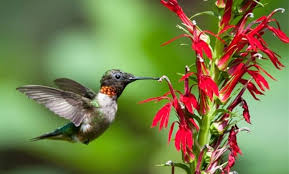
How to Keep Your Hummingbird Feeder Free From Pests

A busy high schooler shares how he got hooked on birds at an early age and what they mean to him.
Audubon Webpages that you might enjoy
